
Best Sales Forecasting Software for 2025
Nov 30, 2025
Nov 30, 2025

Dmytro Chervonyi
CMO at Forecastio
Last updated
Nov 30, 2025
Reading time
15 min
Share:
Share
Table of Contents




In today's data-driven business environment, accurate sales forecasting isn't just helpful—it's essential for strategic decision-making. Modern sales forecasting software transforms how businesses predict future revenue by combining sophisticated AI algorithms with your CRM data to deliver unprecedented accuracy.
What You'll Learn in This Guide
Why traditional forecasting methods fall short for growing businesses
Key features to consider when selecting revenue forecasting tools
In-depth reviews of the top 22 sales forecasting solutions
How AI forecasting tools are revolutionizing revenue predictions
Step-by-step implementation guidance for maximum ROI
Whether you're using HubSpot, Salesforce, or another CRM, this comprehensive guide will help you identify the best forecasting software to transform your sales planning process and hit your revenue targets consistently.
Why CRM and Spreadsheets Aren't Enough for Revenue Forecasting
While many sales teams begin their forecasting journey with basic CRM tools and spreadsheets, these methods quickly show their limitations as organizations scale. Here's why dedicated sales forecasting software has become essential:
The Hidden Costs of Basic Forecasting Methods
Manual Errors: Spreadsheet-based forecasting is prone to formula mistakes, version control issues, and human error—resulting in costly miscalculations
Static Data: Traditional CRM forecasting tools rely on fixed probability percentages that don't adapt to changing market conditions
Limited Visibility: Without advanced analytics, sales leaders lack real-time pipeline insights needed for strategic decisions
Time Waste: Sales teams spend an average of 4-5 hours weekly maintaining manual forecasts—time better spent selling
How AI Forecasting Tools Transform Revenue Predictions
Modern sales forecasting software eliminates these problems through:
Multi-Method Forecasting: Combines pipeline, historical, and AI-driven predictions for superior accuracy
Real-Time Analytics: Provides up-to-the-minute insights on deal progression and pipeline health
Predictive Intelligence: Identifies at-risk opportunities and highlights deals most likely to close
Data Automation: Eliminates manual data entry and ensures consistent forecast updates
For growing businesses, investing in specialized forecasting solutions is no longer optional—it's a competitive necessity to drive accurate forecasting, improve resource allocation, and accelerate revenue growth.

5 Signs You Need Sales Forecasting Software Now
Many revenue teams delay adopting dedicated forecasting tools until missed targets and pipeline confusion become chronic problems. Don't wait for a forecasting crisis—here are the clear indicators it's time to upgrade your forecasting capabilities:
1. Your Sales Team Exceeds 5 Reps
Managing forecasts manually works for very small teams, but forecast accuracy drops sharply once you have 5+ sales reps without proper sales forecasting tools to coordinate predictions.
2. You Manage 100+ Open Deals
When your pipeline grows beyond 100 active opportunities, manual tracking becomes impossible. Sales forecasting software automatically monitors changes across hundreds of deals, dramatically improving sales pipeline visibility.
3. Forecast Variance Exceeds 15-20%
If your actual results consistently miss forecasts by wide margins, you need AI sales forecasting based on real-time data to improve prediction accuracy.
4. You're Forecasting Across Multiple Segments
Basic CRM forecasting can't handle the complexity of multi-region or multi-product forecasting. Advanced forecasting solutions provide the segmented views needed for nuanced analysis.
5. You Spend 3+ Hours Weekly on Manual Updates
When forecast maintenance consumes more than 3 hours weekly, specialized forecasting tools deliver significant ROI through time savings alone.
If two or more of these warning signs apply to your organization, it's time to implement revenue forecasting software before missed forecasts impact business planning.
Best Sales Forecasting Software for 2025: In-Depth Reviews
1. Forecastio: Best AI Forecasting Tool for HubSpot Users

Perfect for: Sales leaders and RevOps teams using HubSpot who want accurate, AI-powered forecasts, deal visibility, and early risk detection - all without complex setup
Key Features:
Seamless HubSpot Integration: Connects in minutes and syncs all deals, pipelines, and forecasts automatically.
Weighted Pipeline Forecasting: Calculates pipeline stage probabilities automatically from historical performance and combines them with deal amounts to generate accurate, real-time forecasts.
AI Forecasting Engine: Uses machine learning to predict both the likelihood of closing each deal and the most probable close date, based on patterns in your HubSpot data.
Comprehensive Audit Trail: Instantly see why your forecast changed - slipped deals, lost deals, amount edits, or probability shifts.
Forecast Accuracy Tracking: Compare forecasted vs actual revenue and track accuracy by rep, team, or forecasting method.
What-If Scenarios: Exclude risky or low-confidence deals to model different outcomes and understand how much of your forecast depends on uncertain opportunities.

Why We Recommend It: Forecastio enhances HubSpot's native forecasting by replacing manual inputs with automation and AI-driven insights. It reduces human bias, predicts close dates more accurately than sales reps’ estimates, and gives sales leaders full transparency into how forecasts evolve. With flexible pricing based on team size, it's a powerful yet accessible forecasting solution for any HubSpot-based sales organization.
Pricing: Paid plans start from $199 per month (billed annually) and scale with team size, making it flexible and affordable for growing sales organizations.

2. Weflow: Best for workflow automation and forecasting
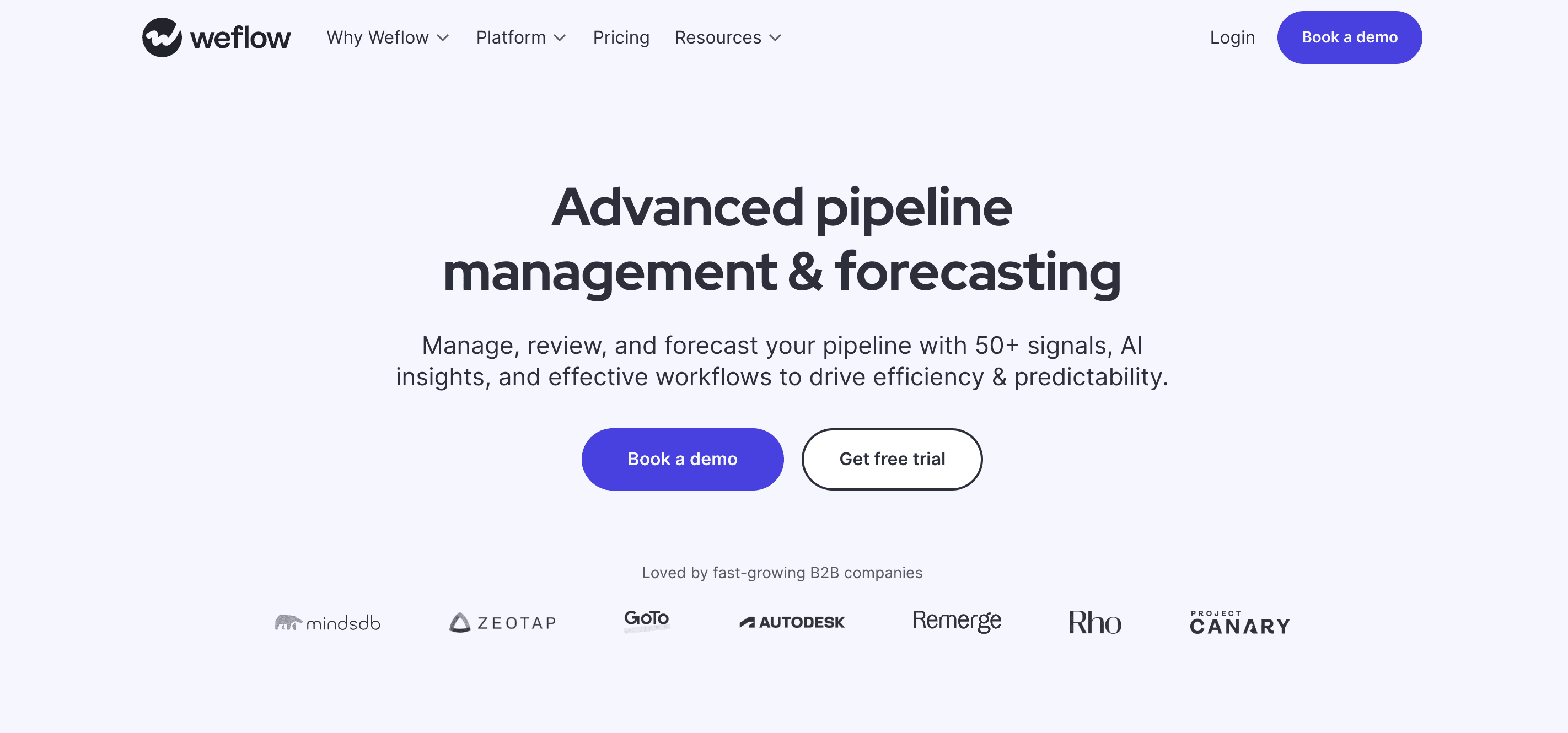
Weflow combines workflow automation with powerful forecasting tools to streamline sales processes and improve forecast accuracy. It is designed to enhance efficiency and productivity for sales teams that use Salesforce CRM.
Key features:
Workflow automation: Automate routine sales tasks to save time and reduce errors.
Accurate forecasting: Provides reliable sales forecasts based on historical data and pipeline analysis.
Custom dashboards: Allows users to create custom dashboards for tracking key metrics.
Benefits:
Efficiency: Automates repetitive tasks, freeing up time for sales activities.
Productivity: Helps sales teams stay organized and focused on high-value tasks.
Pricing:
Plans with forecasting features start at $69/user per month. (billed annually)
3. Scratchpad: Best for seamless Salesforce integration

Scratchpad is designed to simplify sales forecasting by integrating seamlessly with Salesforce CRM. It offers a user-friendly interface and real-time data synchronization, ensuring that your sales forecasts are always based on the latest information.
Key features:
CRM integration: Works seamlessly with Salesforce, eliminating manual data entry.
Real-time updates: Ensure your forecasts are always up-to-date with the latest sales data.
User-friendly interface: Simplifies forecasting with intuitive navigation and customizable dashboards.
Benefits:
Efficiency: Saves time by automating data synchronization with Salesforce CRM.
Accuracy: Real-time updates ensure forecasts reflect sales trends and data.
Pricing:
Paid plans start from $24/user per month.
4. Salesloft: AI-driven forecasting for precision and efficiency

Salesloft offers sales forecasting capabilities designed to help teams refine their forecasts and better understand pipeline health. It includes tools for analyzing deal progress and team performance, aiming to support more informed decision-making.
Key features:
AI-driven insights: Provides precise forecasts by analyzing historical data, pipeline trends, and team performance metrics.
Pipeline health monitoring: Identifies risks and opportunities within the sales pipeline to optimize focus and resource allocation.
Engagement integration: Seamlessly connects forecasting with Salesloft’s sales engagement tools for a unified workflow.
Benefits:
Forecast accuracy: Leveraging AI ensures reliable predictions, enabling data-driven decision-making.
Unified platform: Combines forecasting with engagement tools to streamline sales processes.
Pricing:
For a customized quote, visit Salesloft.com.
Tired of inaccurate forecasts? Book a Forecastio demo and explore how to achieve higher accuracy.
5. Clari: Best for revenue operations and forecasting

Clari is a comprehensive platform designed for revenue operations, offering advanced forecasting tools along with revenue intelligence and pipeline management features for Salesforce and Pipedrive users.
Key features:
Revenue operations: Integrates forecasting with revenue intelligence to provide a complete picture of sales performance.
Pipeline management: Helps manage and optimize the sales pipeline.
AI-powered insights: Use AI to deliver actionable insights and improve forecast accuracy.
Benefits:
Comprehensive: Provides a wide range of tools for revenue operations and forecasting.
Actionable insights: Offer insights that improve sales strategies and outcomes.
Pricing:
To get a customized quote based on your team size, contact Clari. Read this article about top Clari alternatives.
Looking for a detailed comparison between top forecasting and analytics platforms? Read our article Clari vs. Gong to see how they stack up.
6. Gong: Best for conversational analytics and forecasting

Gong leverages conversational analytics to enhance sales forecasting. As a result of analyzing sales conversations, Gong provides unique insights that improve forecast accuracy and sales performance for Salesforce and HubSpot users.
Key features:
Conversational analytics: Analyze sales calls and meetings to extract valuable insights.
AI-driven forecasting: Uses AI to predict sales outcomes based on conversational data.
Performance tracking: Tracks individual and team performance metrics.
Benefits:
Unique insights: Provide insights not available through traditional forecasting methods.
Improved accuracy: Enhances forecast accuracy by incorporating conversational data.
Pricing:
To get a customized quote based on your team size, contact Gong.
If you're exploring tools that integrate sales conversation analytics with forecasting capabilities, read our comparison of Avoma vs. Gong to find the right fit for your business.
7. Kluster: Best for data-driven decision-making

Kluster is an enterprise forecasting sales software focused on data-driven decision-making, providing advanced analytics and forecasting to help sales teams optimize their performance and strategy.
Key features:
Advanced analytics: Offers detailed analytics to support data-driven decisions.
Accurate forecasting: Uses historical data and predictive models to provide reliable forecasts.
Customizable reports: Allows users to create and customize reports to track key metrics.
Benefits:
Data-driven: Empowers sales teams to make informed decisions based on accurate data.
Customization: Offers flexible reporting options to meet specific business needs.
Pricing:
To get a customized quote, contact Kluster.com.
8. HubSpot: Best for comprehensive CRM and sales forecasting

HubSpot is known for its comprehensive CRM capabilities, including sales forecast software with a simple forecasting method –– a weighted pipeline. It provides an all-in-one solution for managing sales, marketing, and customer relationships.
Key features:
Data integration: Seamlessly integrates forecasting with CRM data for accurate predictions.
User-friendly interface: Easy-to-use interface with customizable dashboards.
Comprehensive tools: Offers a wide range of tools for sales, marketing, and customer management.
Benefits:
All-in-One Solution: Combines CRM, sales, and marketing tools on a single platform.
Ease of Use: A user-friendly interface makes it easy for teams to adopt and use.
Pricing:
Pricing plans for HubSpot's Sales Hub ‘Professional’ plan with forecasting features start at $100/seat per month.
9. Pipedrive: Best for visual pipeline management and revenue forecasting for small teams
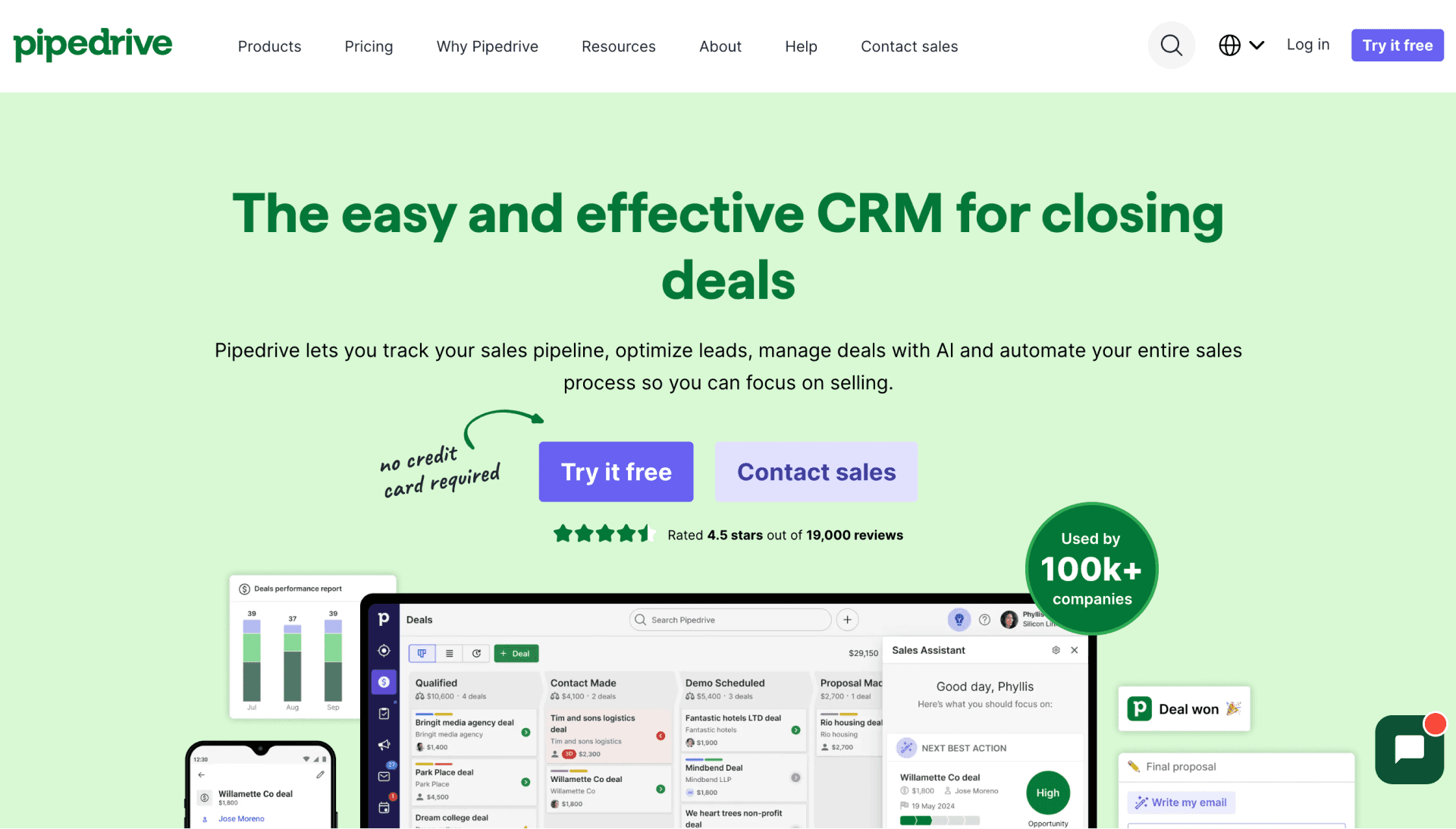
Pipedrive’s forecasting is built into the core CRM, so you get visual pipeline management and data driven revenue predictions. Perfect for small to medium sized sales teams looking for simple sales forecast software.
Features:
Visual pipeline: Drag and drop interface for deals and forecasts
Revenue forecasting: Calculates revenue based on deal probability and historical performance
Progress tracking: Real time updates on sales goals and forecast attainment
Custom fields: Add custom data points for more accurate forecasting
Benefits:
Visibility: Clear visual representation of sales pipeline and forecasted deals
Accuracy: Data driven predictions based on actual sales activities
Simplicity: Easy to use, no training required
Pricing: Professional plan with forecasting starts at $49.90/user per month (billed annually)
For another perspective, check out our Pipedrive vs. HubSpot comparison to determine the best fit for your business.
10. Salesforce: Best for enterprise level sales forecasting and analytics
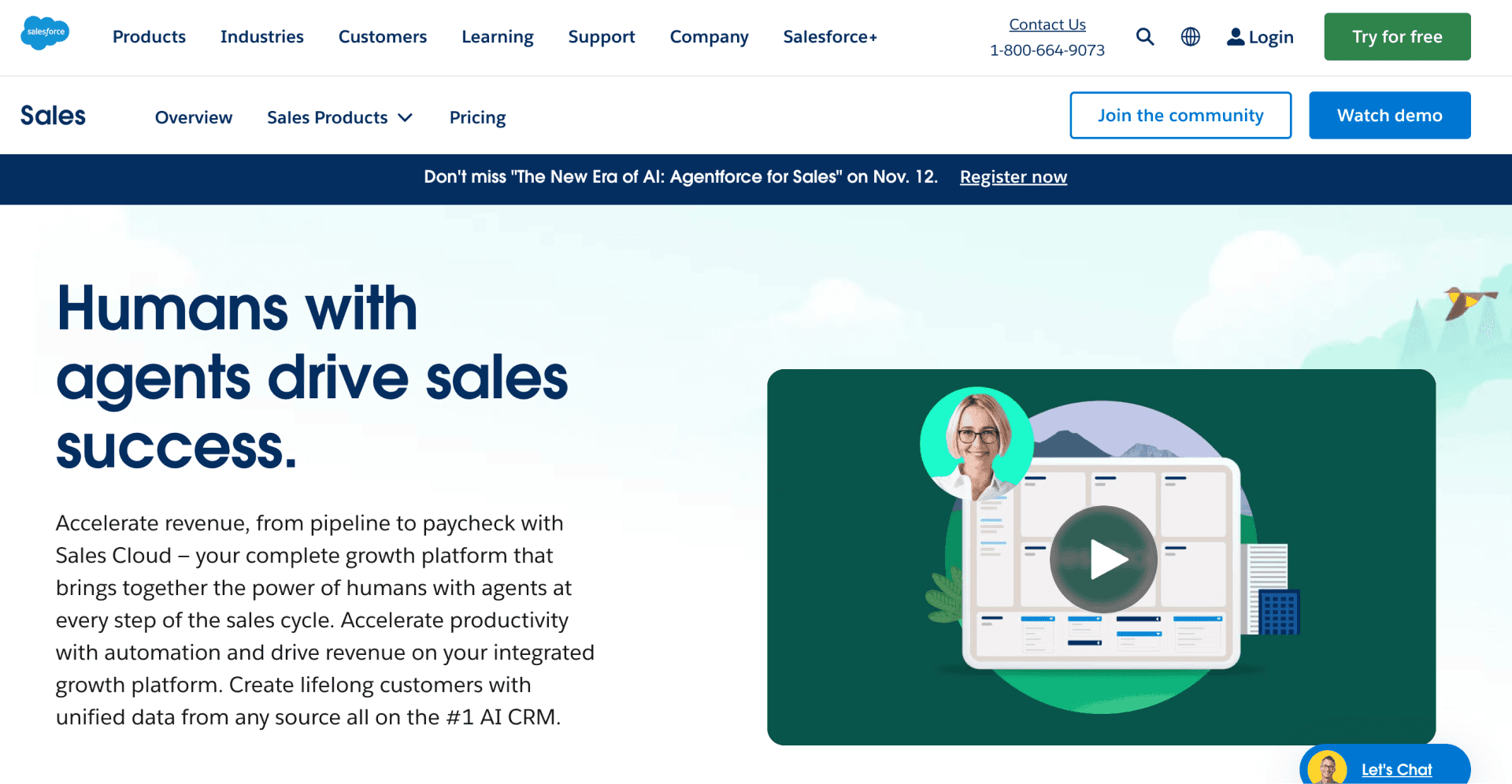
Salesforce forecasting tool built into the Sales Cloud, so you get advanced forecasting software tools for large enterprises with complex sales processes. Perfect for enterprises that need detailed revenue predictions and multi level forecasting hierarchies.
Features:
Collaborative forecasting: Build and share forecasts across org hierarchies
Multiple forecast types: Revenue, quantity, opportunity, product family
AI powered predictions: Einstein AI predicts based on historical patterns
Territory management: Territory based forecasting with org structures
Benefits:
Scalability: Handles complex forecasting for large organizations
Customization: Lots of options to customize forecasting to your business
Integration: Connects with other Salesforce products and third-party tools
Pricing: Sales Cloud Enterprise with Salesforce forecasting tools starts at $165/user per month (billed annually)
Choosing the appropriate CRM is crucial for effective sales forecasting. Our HubSpot vs. Salesforce comparison provides valuable insights.
11. Anaplan: Best for connected planning and enterprise wide forecasting
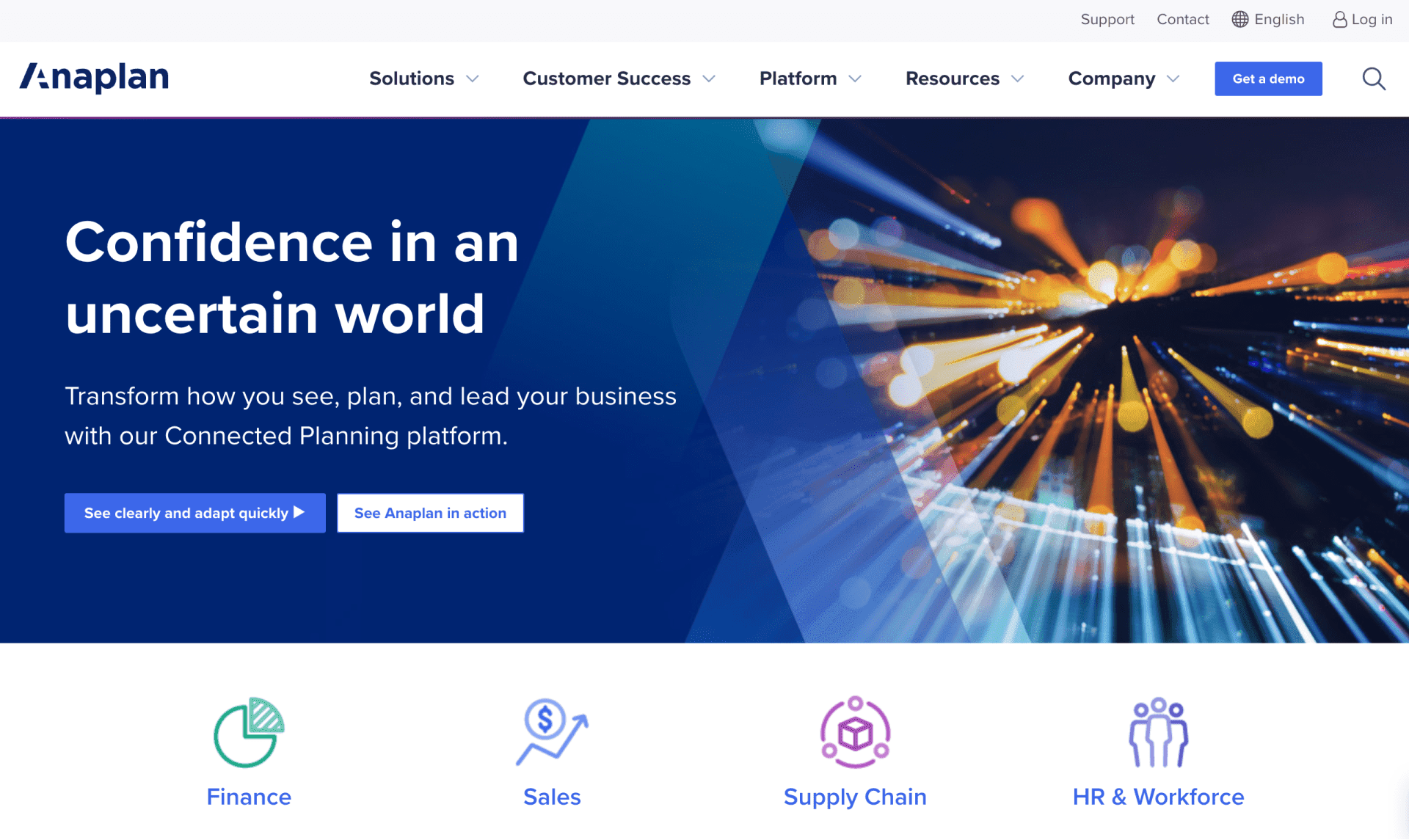
Anaplan is revenue forecasting software built into the Connected Planning platform, so you can integrate financial planning and forecasting software. Perfect for large enterprises that need advanced modeling and cross functional forecasting.
Features:
Connected Planning: Links sales forecasts to financial, supply chain and operational plans
Scenario modeling: Create and compare multiple forecast scenarios in real time
Collaborative forecasting: Cross functional input and planning alignment
Advanced analytics: Complex modeling with built in statistical functions
Benefits:
Integration: Forecasts across all business functions
Flexibility: Customizable models that adapt to complex business needs
Real time updates: Dynamic calculations as data changes across the org
Enterprise scale: Handles large data volumes and complex org structures
Pricing: Enterprise pricing upon request (starts at $30,000/year for basic implementation)
12. Aviso AI Forecasting: Best for AI driven sales forecasting and deal guidance
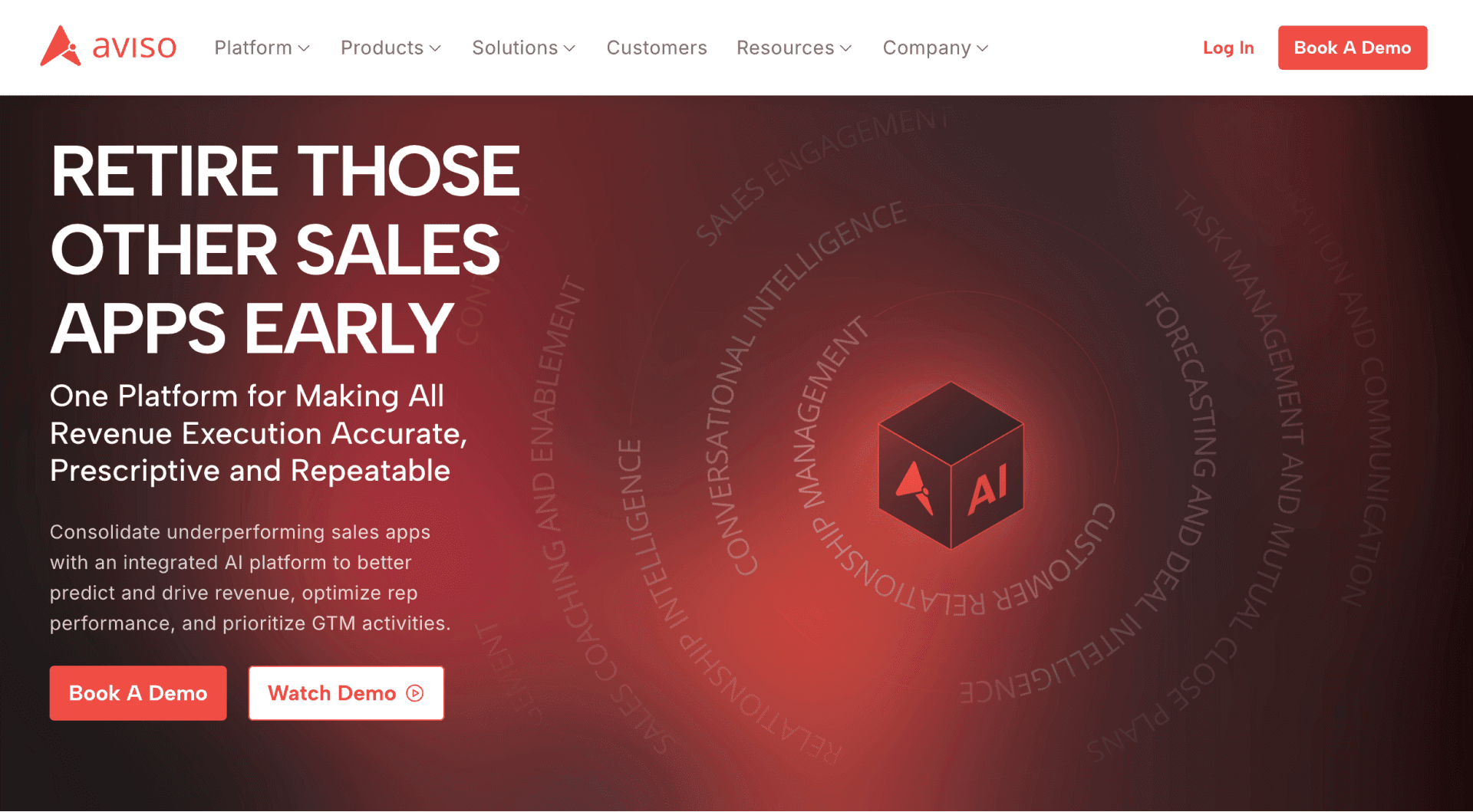
Aviso is AI forecasting software that uses advanced algorithms to provide accurate sales forecasts and deal insights. Perfect for organizations that want data driven forecasting with machine learning to improve prediction and deal execution.
Features:
AI forecasting engine: Machine learning to generate revenue predictions
Deal intelligence: AI powered insights for deal scoring and risk assessment
Win rooms: Collaborative spaces for strategic deal management
Opportunity insights: Advanced analytics for pipeline health and deal progress
CRM integration: Connects with Salesforce and other major CRMs
Benefits:
Accuracy: 95+% forecast accuracy through AI
Actionability: Specific guidance on deal execution and risk mitigation
Automation: Automates manual forecasting
Visibility: Pipeline health and team performance insights
Pricing: Enterprise pricing upon request
13. ForecastX: Best for demand forecasting and statistical analysis in Excel
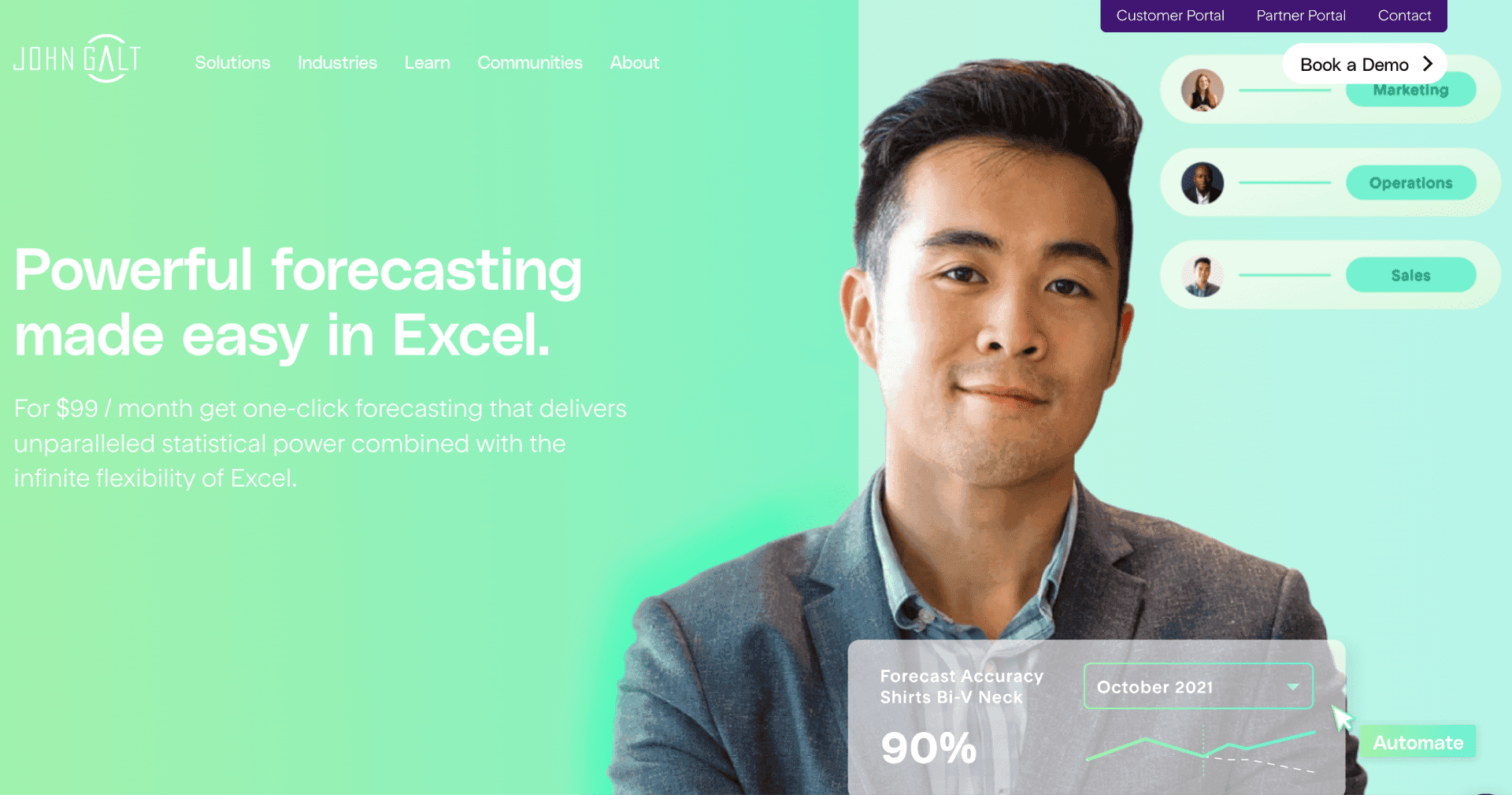
ForecastX is focused on statistical forecasting methods and demand planning, used for inventory and supply chain forecasting. Perfect for organizations that need detailed statistical analysis and multiple forecasting methods in Excel.
Features:
Multiple methods: Time series, regression, smoothing, seasonal analysis
Excel integration: Works as an Excel add-in so you can use it in your familiar spreadsheet
Statistical analysis: Advanced statistical tools for forecast accuracy
Scenario planning: Model multiple forecast scenarios
Demand planning: Tools for inventory and supply chain forecasting
Benefits:
Accuracy: Statistical methods improve forecast reliability
Flexibility: Multiple forecasting methods to fit your business
Familiarity: Excel based interface so you don’t have to learn a new system
Analysis: Detailed statistical reporting and accuracy metrics
Pricing: ForecastX Lite - $59/month, ForecastX - $99/month
14. InsightSquared: Best for revenue intelligence and analytics driven forecasting
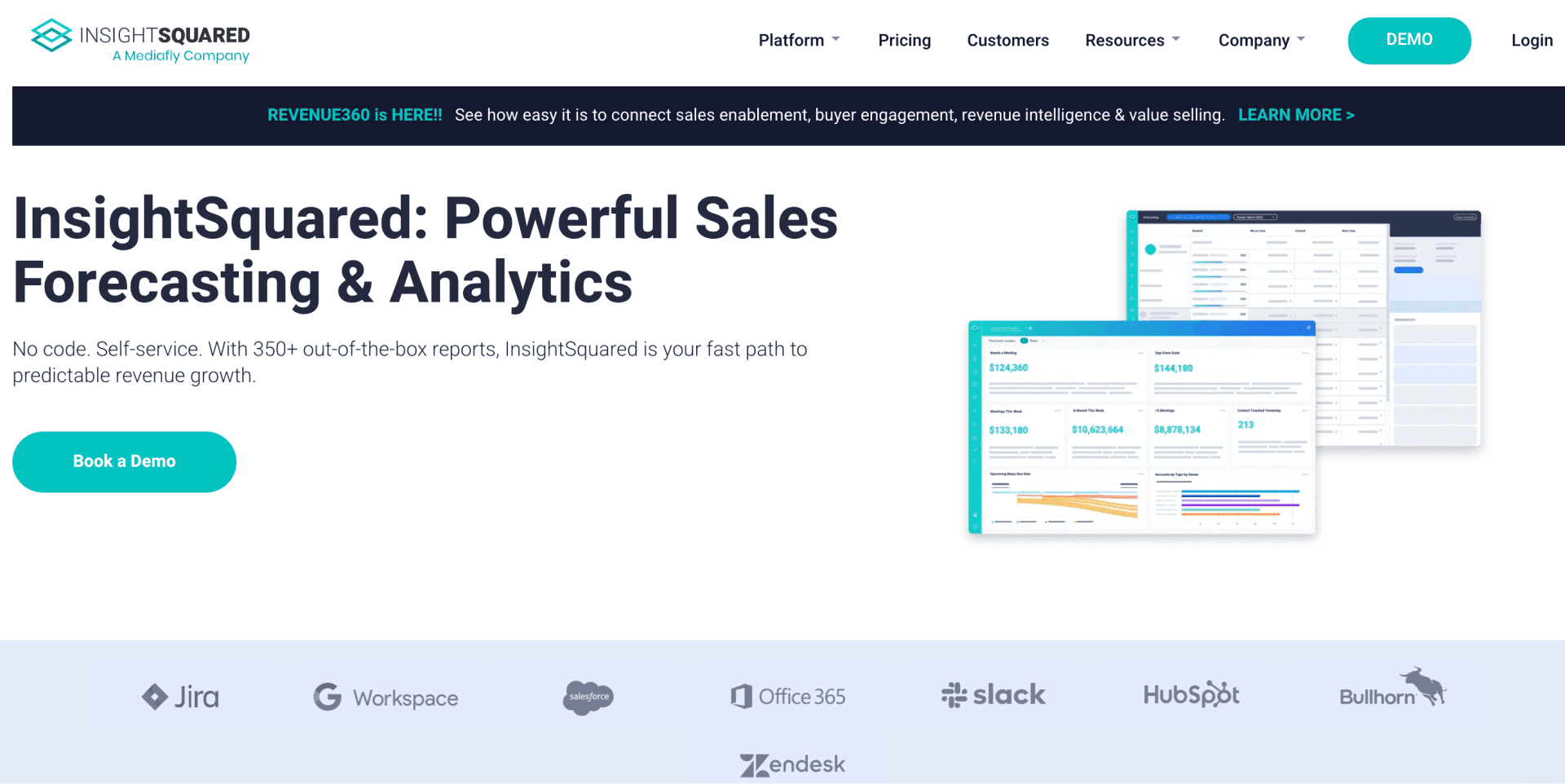
InsightSquared combines revenue intelligence with forecasting to provide sales analytics and predictions. Perfect for B2B companies that need detailed pipeline analytics and AI driven forecasting.
Features:
Revenue intelligence: AI powered insights into pipeline and deal progression
Forecast modeling: Multiple forecast models (commit, best case, pipeline)
Activity capture: Automated tracking of sales activities and customer interactions
Historical analysis: Trend analysis and historical performance
Board reporting: Pre-built board and executive level reporting templates
Benefits:
Visibility: Pipeline health and forecast accuracy insights
Intelligence: AI analysis of sales performance and trends
Reporting: Automated reporting
Integration: Connects with Salesforce and other CRMs
Pricing: Pricing plans upon request
15. SPOTIO: Best for field sales forecasting and territory management

SPOTIO is focused on field sales teams, territory management, route planning and sales forecasting. Perfect for organizations with outside sales teams that need location based forecasting and field activity tracking.
Features:
Territory mapping: Visual territory planning with forecasting
Field activity tracking: Real-time tracking of field sales activities
Pipeline management: Mobile first pipeline and opportunity tracking
Lead management: Lead routing and assignment with forecast impact
Performance analytics: Location based performance and forecast tracking
Benefits:
Mobility: Built for field sales teams with strong mobile capabilities
Efficiency: Route optimization increases field sales productivity
Visibility: Real-time tracking of field activities and forecast progress
Accountability: Activity tracking and performance metrics for field teams
Pricing: Pricing plans upon request (billed annually)
Trying to choose between SalesRabbit and Spotio? Read our in-depth comparison to find the best fit for your sales team’s needs.
16. EngageBay: Best for all-in-one sales and marketing forecasting
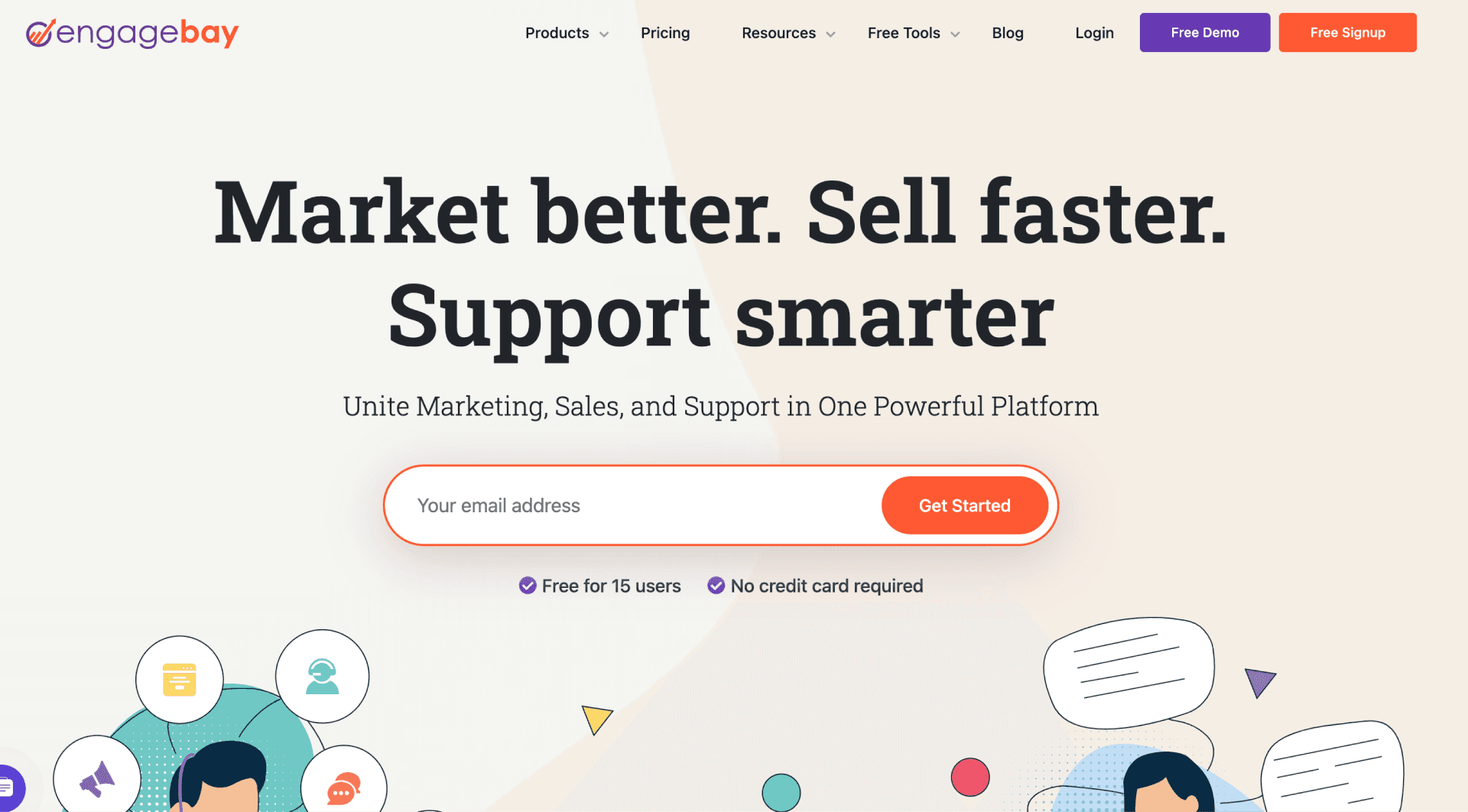
EngageBay combines sales forecasting with full CRM and marketing automation. Perfect for small to medium sized businesses that need an affordable all-in-one solution for sales forecasting and customer engagement.
Features:
Pipeline forecasting: Visual pipeline management with revenue predictions
Deal tracking: Built in deal scoring and probability assessment
Sales automation: Automated workflow for sales processes
Contact management: Contact tracking with forecast impact
Multi-channel tracking: Forecasting across multiple sales channels
Benefits:
Integration: Marketing and sales forecasting connected
Simplicity: Easy to use with minimal learning curve
Scalability: Plans that grow with your business
Pricing: Growth plan with forecasting $59.79/user per month (billed annually)
EngageBay vs. HubSpot: Dive into our detailed comparison to discover which CRM is the perfect match for your business.
17. SalesRabbit: Best for door-to-door and field sales forecasting
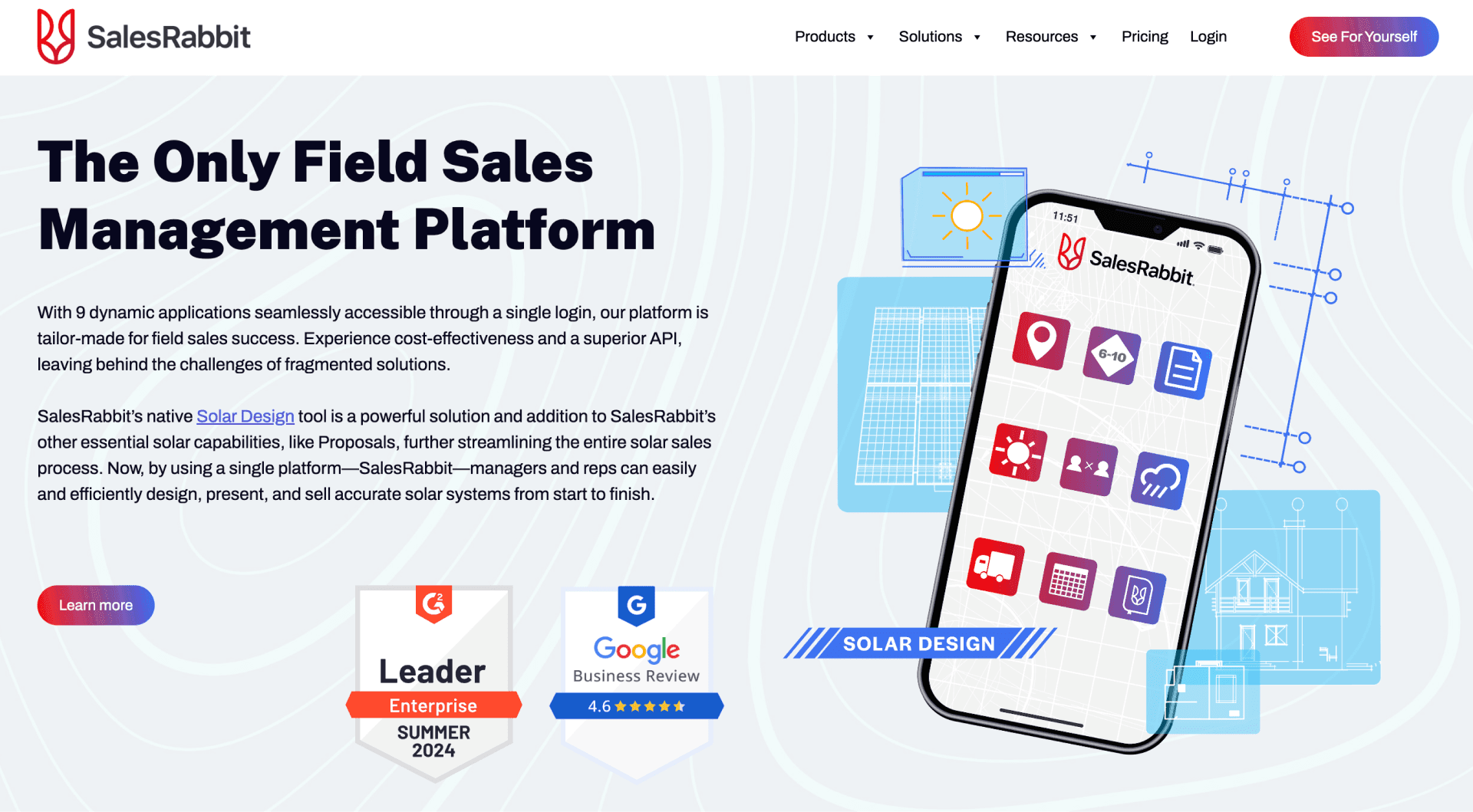
SalesRabbit is focused on field sales management with forecasting, perfect for door-to-door sales teams. For organizations that need territory based forecasting and mobile first sales management.
Features:
Area management: Territory planning and forecasting by area
Lead tracking: GPS lead and opportunity tracking
Mobile CRM: Field friendly customer relationship management
Digital contracts: E-signature with revenue forecasting
Performance tracking: Real-time field activity and forecast monitoring
Benefits:
Field optimization: Increases door-to-door sales productivity and forecast accuracy
Mobile first: Built for field sales teams
Visualization: Strong mapping and territory visualization
Tracking: Activity tracking for better forecast reliability
Pricing: Professional plan $195/user per month (billed annually)
18. Kylas: Best for growing SMBs and sales process automation
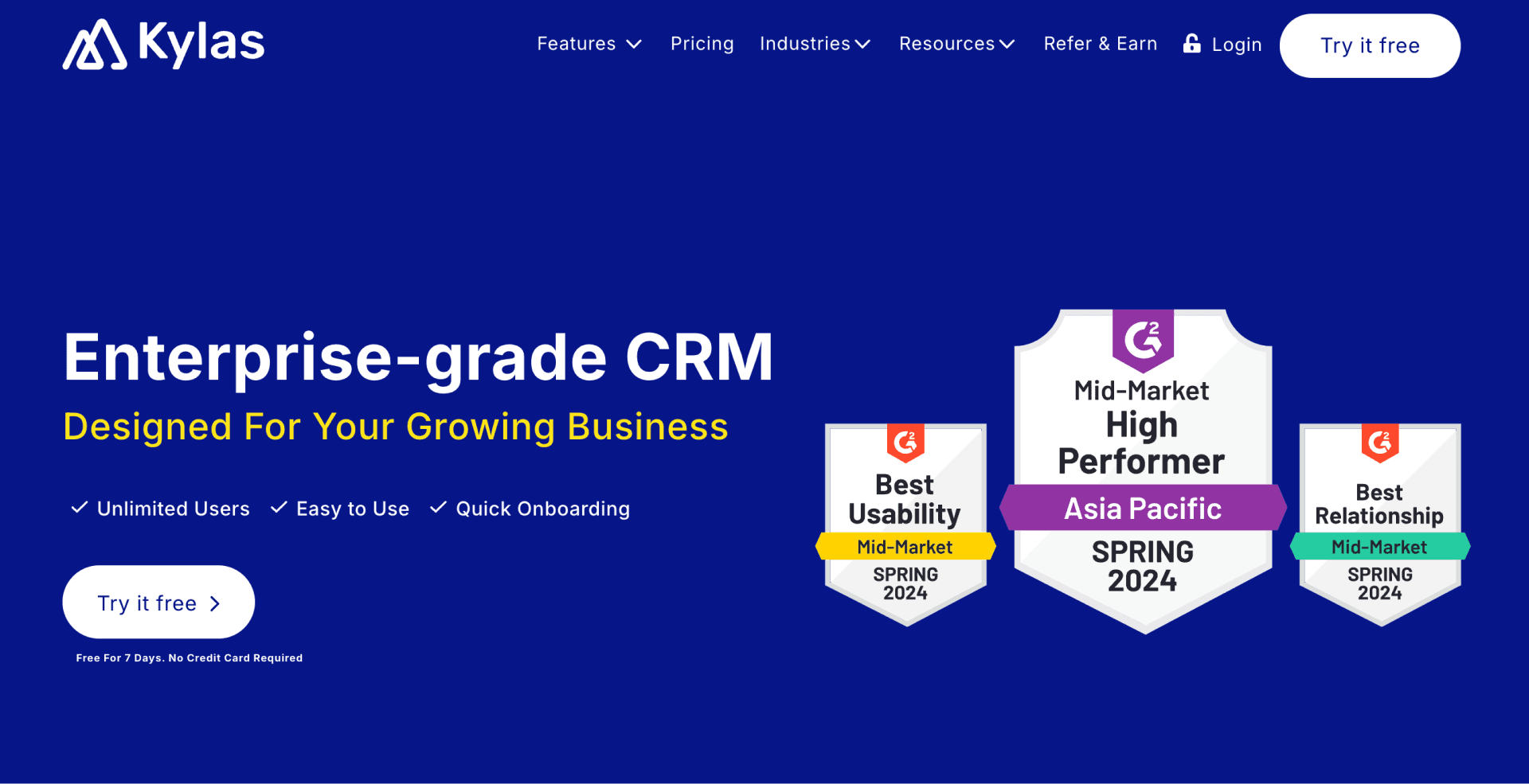
Kylas has sales forecasting built into its CRM, for small to medium sized businesses looking to grow. Perfect for companies that need simple forecasting with basic sales automation.
Features:
Pipeline forecasting: Visual pipeline with revenue predictions
Lead scoring: Lead scoring affects forecast
Sales automation: Automated workflows for sales processes
Custom reporting: Reports for forecast analysis
Mobile access: Mobile access to forecasts and pipeline
Benefits:
Ease of use: Simple to use with minimal training
Customization: Flexible to fit your business processes
Local support: Strong support for local businesses
Pricing: Elevate plan $250/unlimited users per month (billed annually)
19. Xactly Forecasting: Best for incentive compensation driven forecasting
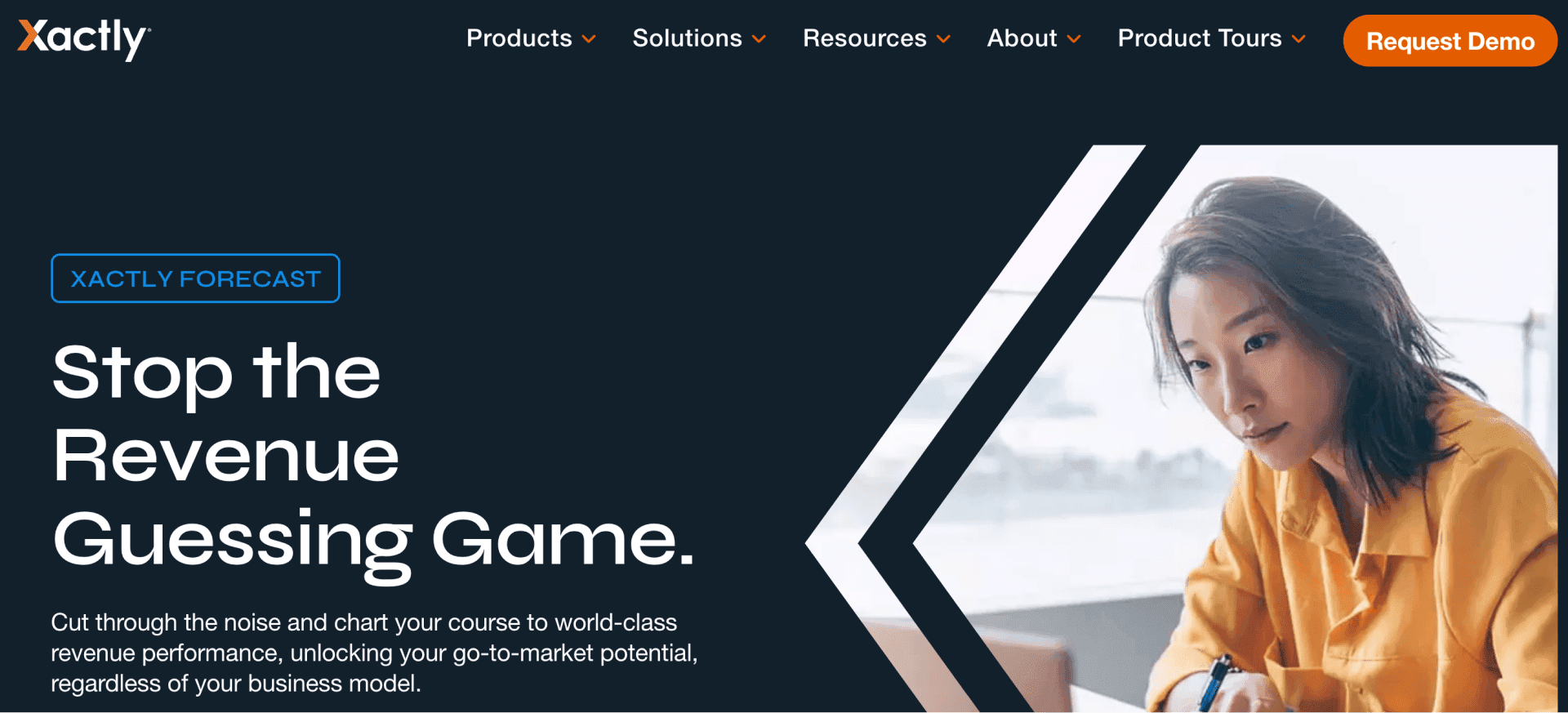
Xactly is sales performance management with advanced forecasting, focused on the relationship between comp and revenue forecasting. For organizations that need to tie sales incentives to forecast and revenue goals.
Features:
AI forecasting: Machine learning for revenue forecasting
Compensation impact: Compensation tied to forecast accuracy
Pipeline analytics: Deep pipeline health and velocity analysis
Territory planning: Territory based forecasting and quota management
Predictive insights: AI driven forecast optimization
Benefits:
Accuracy: Forecast accuracy through incentive alignment
Motivation: Compensation directly tied to forecast performance
Integration: Compensation management connected
Intelligence: Advanced analytics for pipeline and performance
Pricing: Enterprise pricing available upon request. Custom pricing for advanced forecasting and compensation management. Read this article about top Xactly alternatives.
For a detailed comparison of leading commission management tools, explore our analysis of Spiff vs. CaptivateIQ.
20. Revenue Grid: Best for guided selling and revenue intelligence forecasting
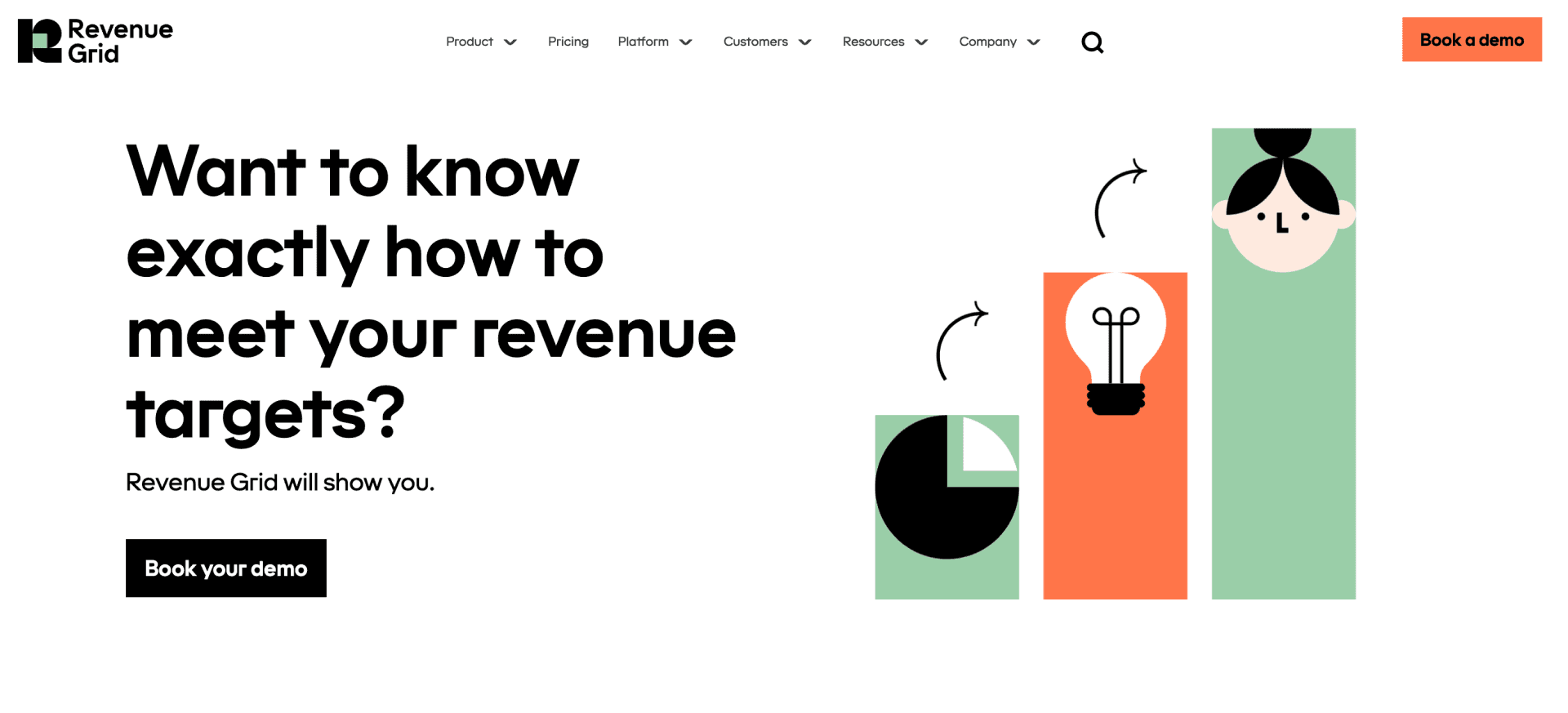
Revenue Grid has AI revenue intelligence with sales engagement features for forecasting. Perfect for organizations that need data driven revenue forecasting with guided selling.
Features:
AI forecasting: Machine learning for revenue forecasting
Guided selling: Step by step guidance for deal progression
Revenue signals: Real-time alerts and insights for forecasts
Pipeline visibility: Deep pipeline analytics and health
Engagement tracking: Automatic tracking of customer interactions
Benefits:
Accuracy: AI powered forecast with behavioral insights
Proactivity: Early warnings for at risk opportunities
Adoption: Native Salesforce integration
Guidance: Recommendations to improve forecast
Pricing: Pricing available upon request.
CashFlowFrog: Best for automated cash flow forecasting

CashFlowFrog is a specialized cash flow forecasting solution that eliminates manual data entry by automatically syncing with your accounting software. It's designed for businesses seeking real-time cash flow visibility and accurate future projections without the complexity of spreadsheets.
Key features:
Automated forecasting: Instantly generates cash flow forecasts by pulling data directly from your accounting software with no manual entry required.
What-if scenarios: Test the impact of various financial decisions like hiring staff, paying bills, or making investments on your future cash flow.
Multi-company consolidation: Easily combine data from multiple entities into a single cash flow forecast.
Benefits:
Accuracy: Real-time synchronization with QuickBooks, Xero, FreshBooks, and Sage Intacct ensures forecasts always reflect your latest financial data.
Time savings: Eliminates hours spent on manual forecasting with automatic data syncing and analysis.
Pricing: Plans start at $29/month with various options based on revenue. Free trial available with no credit card required.
22. LivePlan: Best for business planning and integrated sales forecasting

LivePlan is a comprehensive business planning platform with robust sales forecasting capabilities designed to help entrepreneurs create accurate financial projections without complex spreadsheets or accounting expertise.
Key features:
Automatic financial statements: Creates professional profit & loss, balance sheet, and cash flow statements from your sales forecast with calculations handled automatically.
Accounting integration: Seamlessly syncs with QuickBooks and Xero to import your accounting data for more accurate forecasts based on actual performance.
Multiple scenario planning: Easily test "what-if" scenarios to see how different business decisions would impact your bottom line before committing resources.
Benefits:
Simplicity: Step-by-step guidance makes creating sales forecasts accessible for business owners without financial expertise.
Visualization: Automatically generates professional charts and graphs to clearly present your financial projections for investors or lenders.
Pricing: Plans start at $20/month with premium features available at higher tiers. All plans include a 35-day money-back guarantee.
How to Choose the Best Sales Forecasting Software for Your Business
Choosing the right sales forecasting software is not just about getting another dashboard. It is about finding a tool that helps you understand your pipeline, make better decisions, and predict revenue with confidence. The best sales forecasting tools today use automation, AI, and clean CRM data to help sales teams build accurate forecasts and react faster when something changes.
Below are the features that matter the most.
1. CRM Integration Excellence
Priority question: Does the tool integrate natively with your existing CRM and sales tech stack?
Look for seamless two-way data synchronization that requires minimal IT support. The best forecasting tools for HubSpot or Salesforce offer certified integrations that maintain data integrity across systems.
2. User-Friendly Interface
Priority question: Will your sales team actually use this tool daily?
Evaluate the sales forecasting dashboard for clarity and simplicity. The most effective tools provide intuitive visualization that helps teams instantly understand forecast status and required actions.
3. Multiple Forecasting Methodologies
Priority question: Does the tool support various forecasting approaches?
Effective forecasting software should offer multiple methods:
Pipeline-based forecasting: Weighted by stage or probability
Historical analysis: Time-series forecasting for trend identification
AI prediction: Machine learning for pattern recognition
Bottom-up vs. top-down approaches: Flexibility for different scenarios
4. AI and Machine Learning Capabilities
Priority question: How does the platform use AI to improve forecast accuracy?
Modern teams expect more than stage-based probabilities. Good sales forecasting software should offer AI sales forecasting and ML-driven predictions.
This helps the system:
estimate the probability of closing each deal
predict the most likely close month
detect patterns you can’t see manually
improve accuracy over time
If you want the best sales forecasting software, AI and ML should be non-negotiable.

5. Real-Time Analytics
Priority question: How quickly does the forecast update when deal data changes?
The best forecasting software provides instant updates and alerts when significant forecast shifts occur, enabling proactive pipeline management.
6. Forecast Accuracy Tracking
Priority question: can you measure how accurate your sales forecasts are?
You can’t improve what you don’t measure.
Your sales forecasting software should show:
how accurate your forecasts were in past weeks/months
which reps or segments are over-forecasting
where the biggest gaps or risks are
Accuracy history helps teams understand whether they can trust the numbers and where the forecasting process needs work.
7. Audit Trail for Forecast Changes
Priority question: Can you explain why your forecast changed in a few seconds?
This is one of the most important questions for any sales team. If your forecast changes and you can’t explain why in a few seconds, your forecasting process is not under control. Good sales forecasting software should make it instantly clear:
Who updated the numbers
What fields or deals changed
When the change happened
How those edits affected the final forecast
Which deals increased, decreased, slipped, or were removed
When this information is transparent and easy to access, you can walk into any meeting - with your CEO, CFO, or board - and confidently explain what caused the shift.
If you need 15 minutes, 5 reports, or several Slack messages to figure it out, your current sales forecasting tools are not working for you.
8. What-If Scenario Planning
Priority question: Can you easilty stress-test your forcasts and assess possbile future outcomes?
Good sales forecasting software doesn’t just show what is happening. It helps you test what could happen.
With what-if scenarios, you can model:
best-case and worst-case outcomes
changes in quota
headcount changes
pipeline growth or pipeline slowdown
new pricing or product changes
This type of scenario planning helps leaders prepare for different outcomes instead of reacting too late.
9. Support and Training Resources
Priority question: What implementation and ongoing support is provided?
Evaluate the vendor's onboarding process, customer support quality, and available training resources to ensure successful adoption.
By systematically assessing forecasting tools against these criteria, you'll identify the solution that best matches your organizational needs and provides the clearest path to improved forecast accuracy.
Implementing Sales Forecasting Software: 7-Step Success Plan
Deploying new forecasting software requires careful planning to maximize adoption and ROI. Follow this proven implementation framework to ensure success:
1. Conduct a Comprehensive Needs Assessment
Document current forecasting pain points and accuracy challenges
Survey key stakeholders (sales leaders, reps, operations, finance) about requirements
Analyze historical forecasts to identify recurring accuracy issues
2. Select the Right Forecasting Solution
Prioritize requirements based on your assessment findings
Request targeted demos showing your specific use cases
Check customer references in your industry or business size
3. Prepare Your Data Foundation
Audit CRM data quality and resolve incomplete records
Standardize sales process stages and opportunity definitions
Document sales methodology to align with forecasting approach
4. Develop a Phased Implementation Plan
Start with a pilot team of enthusiastic early adopters
Create a detailed timeline with clear milestones and responsibilities
Establish success metrics for measuring implementation effectiveness
5. Integrate with Your Tech Ecosystem
Configure CRM integration for seamless data flow
Test data synchronization thoroughly before full deployment
Document integration points for future reference
6. Monitor Performance and Gather Feedback
Track forecast accuracy improvements comparing pre/post implementation
Solicit user feedback on interface usability and feature gaps
Document time savings from automated processes
7. Continuously Optimize Your Approach
Refine forecasting models based on accuracy data
Expand user adoption through internal success stories
Schedule regular reviews of forecasting methodology
Pro Tip: The most successful implementations focus on demonstrating early wins. Choose one key forecasting pain point to solve first, document the improvement, and use that success to drive broader adoption.
To understand how AI note-takers can improve your forecasting, see our Fathom vs. Fireflies comparison.

5 Common Mistakes When Choosing Sales Forecasting Software
Choosing the right sales forecasting software can drastically improve visibility, pipeline predictability, and revenue planning. But many teams still end up with tools that don't solve their real forecasting challenges. Here are the most common mistakes companies make when evaluating and purchasing sales forecasting software - and how to avoid them.
Focusing on dashboards instead of forecasting logic
A lot of sales forecasting software looks impressive in demos, but behind the scenes it's still just a weighted pipeline or spreadsheet replacement. If the underlying forecasting logic is weak, the results will stay inaccurate no matter how nice the charts look. The software must be built on real forecasting models, not just reporting templates.
Assuming every team can use the same solution
Some tools are built for high-velocity transactional sales teams; others are better for long enterprise cycles. A common mistake is choosing sales forecasting software that doesn't match your sales motion, data structure, or CRM workflow. The result: low adoption, poor accuracy, and frustrated sales leaders.
Ignoring CRM integration and data quality
Forecast accuracy is only as good as the data behind it. Many teams buy sales forecasting software without realizing how dependent it is on clean CRM data. If the software requires manual exports or doesn't properly sync with HubSpot, Salesforce, or other CRMs, forecasting becomes a spreadsheet exercise again - defeating the purpose.
No audit trail or ability to explain forecast changes
One of the most overlooked features in sales forecasting software is the ability to explain why a forecast changed. If revenue suddenly drops by $200K, leaders should not need to manually inspect every deal. Software without a forecast audit log leaves RevOps and sales managers guessing instead of acting.
No accuracy tracking or model comparison
Many platforms can generate a forecast - but cannot measure if their forecast was accurate. If a tool doesn't track forecasting accuracy over time, compare different forecast models, or show how projections improve, teams are forced to manage accuracy manually. Any serious sales forecasting software must include accuracy dashboards, trend analysis, and method comparison.
Quick Summary
When evaluating sales forecasting software, avoid tools that are just visual dashboards, don't integrate well with your CRM, lack audit trails, or don't measure accuracy. The best forecasting platforms go beyond reporting - they explain pipeline changes, track accuracy, and help leaders trust their forecast.
FAQs: Sales Forecasting Software Essentials
What is sales forecasting software?
Sales forecasting software helps businesses predict future revenue by analyzing historical data, pipeline information, and market trends. These specialized tools use AI algorithms and statistical models to provide accurate sales predictions that guide strategic decision-making, resource allocation, and growth planning.
How does sales forecasting software work?
Sales forecasting tools collect data from your CRM, sales pipeline, and other business systems. They then apply various forecasting methodologies—including AI forecasting, time-series analysis, and probability modeling—to identify patterns and predict future outcomes with greater accuracy than manual methods can achieve.
What are the benefits of using sales forecasting software?
Implementing dedicated forecasting software delivers multiple advantages:
Improved Accuracy: Reduces forecast variance by 25-40% on average
Time Savings: Eliminates hours of manual spreadsheet maintenance
Better Decision-Making: Provides data-driven insights for resource allocation
Risk Reduction: Identifies potential shortfalls before they impact results
Increased Accountability: Creates transparency across sales organization
What features should I look for in sales forecasting tools?
Essential capabilities for effective forecasting include:
CRM Integration: Seamless connection with your existing systems
Multiple Forecasting Methods: Support for different prediction approaches
AI-Powered Analytics: Machine learning to improve accuracy over time
Real-Time Updates: Instant recalculation as pipeline changes occur
Intuitive Dashboards: Visual displays for at-a-glance understanding
Collaboration Tools: Shared insights across revenue teams
How do I choose the best forecasting software for my business?
Select forecasting software based on your specific business needs:
For small businesses: Look for affordable solutions with simple implementation
For mid-market companies: Prioritize forecasting tools with strong CRM integration
For enterprises: Seek platforms with advanced analytics and multi-territory capabilities
For HubSpot users: Choose forecasting software with certified HubSpot integration
For Salesforce users: Select tools with native Salesforce connectivity
Can sales forecasting software integrate with my current CRM?
Most leading sales forecasting solutions offer pre-built integrations with popular CRM platforms like HubSpot, Salesforce, and Pipedrive. These native connections allow for real-time data synchronization, eliminating manual updates and ensuring forecast accuracy.
What is the best tool for forecasting sales?
The ideal forecasting tool depends on your business requirements and CRM platform:
For HubSpot users: Forecastio offers the most seamless integration and functionality
For Salesforce users: Clari and InsightSquared provide robust enterprise capabilities
For data-driven organizations: Aviso AI delivers sophisticated forecasting models
For visual pipeline management: Pipedrive combines simplicity with effective forecasting
What is the difference between CRM forecasting and dedicated forecasting software?
CRM forecasting relies on basic weighted pipeline calculations with manually set probabilities, while dedicated forecasting software employs AI, multiple forecasting methods, and advanced analytics to deliver significantly higher accuracy and deeper pipeline insights.
Transform Your Revenue Forecasting with the Right Tools
Accurate sales forecasting is no longer optional for growth-focused businesses. By implementing the right forecasting software, your organization can:
Predict revenue with confidence using AI-powered forecasting algorithms
Make data-driven decisions based on reliable pipeline analytics
Align sales and finance teams around trusted forecast numbers
Identify risks and opportunities before they impact results
Drive consistent revenue growth through improved planning
This guide has explored the top sales forecasting solutions for 2025, from specialized tools like Forecastio to enterprise platforms like Clari and Salesforce. The right choice depends on your specific business needs, existing technology ecosystem, and growth objectives.
Remember that implementation success requires more than selecting the right tool—it demands clean data, clear processes, and team-wide adoption. By following the guidance in this article, you'll be well-positioned to select and implement revenue forecasting software that transforms your sales planning capabilities.
Ready to Improve Your Forecast Accuracy?
Experience the power of modern sales forecasting with Forecastio, designed specifically to enhance HubSpot's native capabilities with advanced AI and multi-method forecasting.
In today's data-driven business environment, accurate sales forecasting isn't just helpful—it's essential for strategic decision-making. Modern sales forecasting software transforms how businesses predict future revenue by combining sophisticated AI algorithms with your CRM data to deliver unprecedented accuracy.
What You'll Learn in This Guide
Why traditional forecasting methods fall short for growing businesses
Key features to consider when selecting revenue forecasting tools
In-depth reviews of the top 22 sales forecasting solutions
How AI forecasting tools are revolutionizing revenue predictions
Step-by-step implementation guidance for maximum ROI
Whether you're using HubSpot, Salesforce, or another CRM, this comprehensive guide will help you identify the best forecasting software to transform your sales planning process and hit your revenue targets consistently.
Why CRM and Spreadsheets Aren't Enough for Revenue Forecasting
While many sales teams begin their forecasting journey with basic CRM tools and spreadsheets, these methods quickly show their limitations as organizations scale. Here's why dedicated sales forecasting software has become essential:
The Hidden Costs of Basic Forecasting Methods
Manual Errors: Spreadsheet-based forecasting is prone to formula mistakes, version control issues, and human error—resulting in costly miscalculations
Static Data: Traditional CRM forecasting tools rely on fixed probability percentages that don't adapt to changing market conditions
Limited Visibility: Without advanced analytics, sales leaders lack real-time pipeline insights needed for strategic decisions
Time Waste: Sales teams spend an average of 4-5 hours weekly maintaining manual forecasts—time better spent selling
How AI Forecasting Tools Transform Revenue Predictions
Modern sales forecasting software eliminates these problems through:
Multi-Method Forecasting: Combines pipeline, historical, and AI-driven predictions for superior accuracy
Real-Time Analytics: Provides up-to-the-minute insights on deal progression and pipeline health
Predictive Intelligence: Identifies at-risk opportunities and highlights deals most likely to close
Data Automation: Eliminates manual data entry and ensures consistent forecast updates
For growing businesses, investing in specialized forecasting solutions is no longer optional—it's a competitive necessity to drive accurate forecasting, improve resource allocation, and accelerate revenue growth.

5 Signs You Need Sales Forecasting Software Now
Many revenue teams delay adopting dedicated forecasting tools until missed targets and pipeline confusion become chronic problems. Don't wait for a forecasting crisis—here are the clear indicators it's time to upgrade your forecasting capabilities:
1. Your Sales Team Exceeds 5 Reps
Managing forecasts manually works for very small teams, but forecast accuracy drops sharply once you have 5+ sales reps without proper sales forecasting tools to coordinate predictions.
2. You Manage 100+ Open Deals
When your pipeline grows beyond 100 active opportunities, manual tracking becomes impossible. Sales forecasting software automatically monitors changes across hundreds of deals, dramatically improving sales pipeline visibility.
3. Forecast Variance Exceeds 15-20%
If your actual results consistently miss forecasts by wide margins, you need AI sales forecasting based on real-time data to improve prediction accuracy.
4. You're Forecasting Across Multiple Segments
Basic CRM forecasting can't handle the complexity of multi-region or multi-product forecasting. Advanced forecasting solutions provide the segmented views needed for nuanced analysis.
5. You Spend 3+ Hours Weekly on Manual Updates
When forecast maintenance consumes more than 3 hours weekly, specialized forecasting tools deliver significant ROI through time savings alone.
If two or more of these warning signs apply to your organization, it's time to implement revenue forecasting software before missed forecasts impact business planning.
Best Sales Forecasting Software for 2025: In-Depth Reviews
1. Forecastio: Best AI Forecasting Tool for HubSpot Users

Perfect for: Sales leaders and RevOps teams using HubSpot who want accurate, AI-powered forecasts, deal visibility, and early risk detection - all without complex setup
Key Features:
Seamless HubSpot Integration: Connects in minutes and syncs all deals, pipelines, and forecasts automatically.
Weighted Pipeline Forecasting: Calculates pipeline stage probabilities automatically from historical performance and combines them with deal amounts to generate accurate, real-time forecasts.
AI Forecasting Engine: Uses machine learning to predict both the likelihood of closing each deal and the most probable close date, based on patterns in your HubSpot data.
Comprehensive Audit Trail: Instantly see why your forecast changed - slipped deals, lost deals, amount edits, or probability shifts.
Forecast Accuracy Tracking: Compare forecasted vs actual revenue and track accuracy by rep, team, or forecasting method.
What-If Scenarios: Exclude risky or low-confidence deals to model different outcomes and understand how much of your forecast depends on uncertain opportunities.

Why We Recommend It: Forecastio enhances HubSpot's native forecasting by replacing manual inputs with automation and AI-driven insights. It reduces human bias, predicts close dates more accurately than sales reps’ estimates, and gives sales leaders full transparency into how forecasts evolve. With flexible pricing based on team size, it's a powerful yet accessible forecasting solution for any HubSpot-based sales organization.
Pricing: Paid plans start from $199 per month (billed annually) and scale with team size, making it flexible and affordable for growing sales organizations.

2. Weflow: Best for workflow automation and forecasting

Weflow combines workflow automation with powerful forecasting tools to streamline sales processes and improve forecast accuracy. It is designed to enhance efficiency and productivity for sales teams that use Salesforce CRM.
Key features:
Workflow automation: Automate routine sales tasks to save time and reduce errors.
Accurate forecasting: Provides reliable sales forecasts based on historical data and pipeline analysis.
Custom dashboards: Allows users to create custom dashboards for tracking key metrics.
Benefits:
Efficiency: Automates repetitive tasks, freeing up time for sales activities.
Productivity: Helps sales teams stay organized and focused on high-value tasks.
Pricing:
Plans with forecasting features start at $69/user per month. (billed annually)
3. Scratchpad: Best for seamless Salesforce integration

Scratchpad is designed to simplify sales forecasting by integrating seamlessly with Salesforce CRM. It offers a user-friendly interface and real-time data synchronization, ensuring that your sales forecasts are always based on the latest information.
Key features:
CRM integration: Works seamlessly with Salesforce, eliminating manual data entry.
Real-time updates: Ensure your forecasts are always up-to-date with the latest sales data.
User-friendly interface: Simplifies forecasting with intuitive navigation and customizable dashboards.
Benefits:
Efficiency: Saves time by automating data synchronization with Salesforce CRM.
Accuracy: Real-time updates ensure forecasts reflect sales trends and data.
Pricing:
Paid plans start from $24/user per month.
4. Salesloft: AI-driven forecasting for precision and efficiency

Salesloft offers sales forecasting capabilities designed to help teams refine their forecasts and better understand pipeline health. It includes tools for analyzing deal progress and team performance, aiming to support more informed decision-making.
Key features:
AI-driven insights: Provides precise forecasts by analyzing historical data, pipeline trends, and team performance metrics.
Pipeline health monitoring: Identifies risks and opportunities within the sales pipeline to optimize focus and resource allocation.
Engagement integration: Seamlessly connects forecasting with Salesloft’s sales engagement tools for a unified workflow.
Benefits:
Forecast accuracy: Leveraging AI ensures reliable predictions, enabling data-driven decision-making.
Unified platform: Combines forecasting with engagement tools to streamline sales processes.
Pricing:
For a customized quote, visit Salesloft.com.
Tired of inaccurate forecasts? Book a Forecastio demo and explore how to achieve higher accuracy.
5. Clari: Best for revenue operations and forecasting

Clari is a comprehensive platform designed for revenue operations, offering advanced forecasting tools along with revenue intelligence and pipeline management features for Salesforce and Pipedrive users.
Key features:
Revenue operations: Integrates forecasting with revenue intelligence to provide a complete picture of sales performance.
Pipeline management: Helps manage and optimize the sales pipeline.
AI-powered insights: Use AI to deliver actionable insights and improve forecast accuracy.
Benefits:
Comprehensive: Provides a wide range of tools for revenue operations and forecasting.
Actionable insights: Offer insights that improve sales strategies and outcomes.
Pricing:
To get a customized quote based on your team size, contact Clari. Read this article about top Clari alternatives.
Looking for a detailed comparison between top forecasting and analytics platforms? Read our article Clari vs. Gong to see how they stack up.
6. Gong: Best for conversational analytics and forecasting

Gong leverages conversational analytics to enhance sales forecasting. As a result of analyzing sales conversations, Gong provides unique insights that improve forecast accuracy and sales performance for Salesforce and HubSpot users.
Key features:
Conversational analytics: Analyze sales calls and meetings to extract valuable insights.
AI-driven forecasting: Uses AI to predict sales outcomes based on conversational data.
Performance tracking: Tracks individual and team performance metrics.
Benefits:
Unique insights: Provide insights not available through traditional forecasting methods.
Improved accuracy: Enhances forecast accuracy by incorporating conversational data.
Pricing:
To get a customized quote based on your team size, contact Gong.
If you're exploring tools that integrate sales conversation analytics with forecasting capabilities, read our comparison of Avoma vs. Gong to find the right fit for your business.
7. Kluster: Best for data-driven decision-making

Kluster is an enterprise forecasting sales software focused on data-driven decision-making, providing advanced analytics and forecasting to help sales teams optimize their performance and strategy.
Key features:
Advanced analytics: Offers detailed analytics to support data-driven decisions.
Accurate forecasting: Uses historical data and predictive models to provide reliable forecasts.
Customizable reports: Allows users to create and customize reports to track key metrics.
Benefits:
Data-driven: Empowers sales teams to make informed decisions based on accurate data.
Customization: Offers flexible reporting options to meet specific business needs.
Pricing:
To get a customized quote, contact Kluster.com.
8. HubSpot: Best for comprehensive CRM and sales forecasting

HubSpot is known for its comprehensive CRM capabilities, including sales forecast software with a simple forecasting method –– a weighted pipeline. It provides an all-in-one solution for managing sales, marketing, and customer relationships.
Key features:
Data integration: Seamlessly integrates forecasting with CRM data for accurate predictions.
User-friendly interface: Easy-to-use interface with customizable dashboards.
Comprehensive tools: Offers a wide range of tools for sales, marketing, and customer management.
Benefits:
All-in-One Solution: Combines CRM, sales, and marketing tools on a single platform.
Ease of Use: A user-friendly interface makes it easy for teams to adopt and use.
Pricing:
Pricing plans for HubSpot's Sales Hub ‘Professional’ plan with forecasting features start at $100/seat per month.
9. Pipedrive: Best for visual pipeline management and revenue forecasting for small teams

Pipedrive’s forecasting is built into the core CRM, so you get visual pipeline management and data driven revenue predictions. Perfect for small to medium sized sales teams looking for simple sales forecast software.
Features:
Visual pipeline: Drag and drop interface for deals and forecasts
Revenue forecasting: Calculates revenue based on deal probability and historical performance
Progress tracking: Real time updates on sales goals and forecast attainment
Custom fields: Add custom data points for more accurate forecasting
Benefits:
Visibility: Clear visual representation of sales pipeline and forecasted deals
Accuracy: Data driven predictions based on actual sales activities
Simplicity: Easy to use, no training required
Pricing: Professional plan with forecasting starts at $49.90/user per month (billed annually)
For another perspective, check out our Pipedrive vs. HubSpot comparison to determine the best fit for your business.
10. Salesforce: Best for enterprise level sales forecasting and analytics

Salesforce forecasting tool built into the Sales Cloud, so you get advanced forecasting software tools for large enterprises with complex sales processes. Perfect for enterprises that need detailed revenue predictions and multi level forecasting hierarchies.
Features:
Collaborative forecasting: Build and share forecasts across org hierarchies
Multiple forecast types: Revenue, quantity, opportunity, product family
AI powered predictions: Einstein AI predicts based on historical patterns
Territory management: Territory based forecasting with org structures
Benefits:
Scalability: Handles complex forecasting for large organizations
Customization: Lots of options to customize forecasting to your business
Integration: Connects with other Salesforce products and third-party tools
Pricing: Sales Cloud Enterprise with Salesforce forecasting tools starts at $165/user per month (billed annually)
Choosing the appropriate CRM is crucial for effective sales forecasting. Our HubSpot vs. Salesforce comparison provides valuable insights.
11. Anaplan: Best for connected planning and enterprise wide forecasting

Anaplan is revenue forecasting software built into the Connected Planning platform, so you can integrate financial planning and forecasting software. Perfect for large enterprises that need advanced modeling and cross functional forecasting.
Features:
Connected Planning: Links sales forecasts to financial, supply chain and operational plans
Scenario modeling: Create and compare multiple forecast scenarios in real time
Collaborative forecasting: Cross functional input and planning alignment
Advanced analytics: Complex modeling with built in statistical functions
Benefits:
Integration: Forecasts across all business functions
Flexibility: Customizable models that adapt to complex business needs
Real time updates: Dynamic calculations as data changes across the org
Enterprise scale: Handles large data volumes and complex org structures
Pricing: Enterprise pricing upon request (starts at $30,000/year for basic implementation)
12. Aviso AI Forecasting: Best for AI driven sales forecasting and deal guidance

Aviso is AI forecasting software that uses advanced algorithms to provide accurate sales forecasts and deal insights. Perfect for organizations that want data driven forecasting with machine learning to improve prediction and deal execution.
Features:
AI forecasting engine: Machine learning to generate revenue predictions
Deal intelligence: AI powered insights for deal scoring and risk assessment
Win rooms: Collaborative spaces for strategic deal management
Opportunity insights: Advanced analytics for pipeline health and deal progress
CRM integration: Connects with Salesforce and other major CRMs
Benefits:
Accuracy: 95+% forecast accuracy through AI
Actionability: Specific guidance on deal execution and risk mitigation
Automation: Automates manual forecasting
Visibility: Pipeline health and team performance insights
Pricing: Enterprise pricing upon request
13. ForecastX: Best for demand forecasting and statistical analysis in Excel

ForecastX is focused on statistical forecasting methods and demand planning, used for inventory and supply chain forecasting. Perfect for organizations that need detailed statistical analysis and multiple forecasting methods in Excel.
Features:
Multiple methods: Time series, regression, smoothing, seasonal analysis
Excel integration: Works as an Excel add-in so you can use it in your familiar spreadsheet
Statistical analysis: Advanced statistical tools for forecast accuracy
Scenario planning: Model multiple forecast scenarios
Demand planning: Tools for inventory and supply chain forecasting
Benefits:
Accuracy: Statistical methods improve forecast reliability
Flexibility: Multiple forecasting methods to fit your business
Familiarity: Excel based interface so you don’t have to learn a new system
Analysis: Detailed statistical reporting and accuracy metrics
Pricing: ForecastX Lite - $59/month, ForecastX - $99/month
14. InsightSquared: Best for revenue intelligence and analytics driven forecasting

InsightSquared combines revenue intelligence with forecasting to provide sales analytics and predictions. Perfect for B2B companies that need detailed pipeline analytics and AI driven forecasting.
Features:
Revenue intelligence: AI powered insights into pipeline and deal progression
Forecast modeling: Multiple forecast models (commit, best case, pipeline)
Activity capture: Automated tracking of sales activities and customer interactions
Historical analysis: Trend analysis and historical performance
Board reporting: Pre-built board and executive level reporting templates
Benefits:
Visibility: Pipeline health and forecast accuracy insights
Intelligence: AI analysis of sales performance and trends
Reporting: Automated reporting
Integration: Connects with Salesforce and other CRMs
Pricing: Pricing plans upon request
15. SPOTIO: Best for field sales forecasting and territory management

SPOTIO is focused on field sales teams, territory management, route planning and sales forecasting. Perfect for organizations with outside sales teams that need location based forecasting and field activity tracking.
Features:
Territory mapping: Visual territory planning with forecasting
Field activity tracking: Real-time tracking of field sales activities
Pipeline management: Mobile first pipeline and opportunity tracking
Lead management: Lead routing and assignment with forecast impact
Performance analytics: Location based performance and forecast tracking
Benefits:
Mobility: Built for field sales teams with strong mobile capabilities
Efficiency: Route optimization increases field sales productivity
Visibility: Real-time tracking of field activities and forecast progress
Accountability: Activity tracking and performance metrics for field teams
Pricing: Pricing plans upon request (billed annually)
Trying to choose between SalesRabbit and Spotio? Read our in-depth comparison to find the best fit for your sales team’s needs.
16. EngageBay: Best for all-in-one sales and marketing forecasting

EngageBay combines sales forecasting with full CRM and marketing automation. Perfect for small to medium sized businesses that need an affordable all-in-one solution for sales forecasting and customer engagement.
Features:
Pipeline forecasting: Visual pipeline management with revenue predictions
Deal tracking: Built in deal scoring and probability assessment
Sales automation: Automated workflow for sales processes
Contact management: Contact tracking with forecast impact
Multi-channel tracking: Forecasting across multiple sales channels
Benefits:
Integration: Marketing and sales forecasting connected
Simplicity: Easy to use with minimal learning curve
Scalability: Plans that grow with your business
Pricing: Growth plan with forecasting $59.79/user per month (billed annually)
EngageBay vs. HubSpot: Dive into our detailed comparison to discover which CRM is the perfect match for your business.
17. SalesRabbit: Best for door-to-door and field sales forecasting

SalesRabbit is focused on field sales management with forecasting, perfect for door-to-door sales teams. For organizations that need territory based forecasting and mobile first sales management.
Features:
Area management: Territory planning and forecasting by area
Lead tracking: GPS lead and opportunity tracking
Mobile CRM: Field friendly customer relationship management
Digital contracts: E-signature with revenue forecasting
Performance tracking: Real-time field activity and forecast monitoring
Benefits:
Field optimization: Increases door-to-door sales productivity and forecast accuracy
Mobile first: Built for field sales teams
Visualization: Strong mapping and territory visualization
Tracking: Activity tracking for better forecast reliability
Pricing: Professional plan $195/user per month (billed annually)
18. Kylas: Best for growing SMBs and sales process automation

Kylas has sales forecasting built into its CRM, for small to medium sized businesses looking to grow. Perfect for companies that need simple forecasting with basic sales automation.
Features:
Pipeline forecasting: Visual pipeline with revenue predictions
Lead scoring: Lead scoring affects forecast
Sales automation: Automated workflows for sales processes
Custom reporting: Reports for forecast analysis
Mobile access: Mobile access to forecasts and pipeline
Benefits:
Ease of use: Simple to use with minimal training
Customization: Flexible to fit your business processes
Local support: Strong support for local businesses
Pricing: Elevate plan $250/unlimited users per month (billed annually)
19. Xactly Forecasting: Best for incentive compensation driven forecasting

Xactly is sales performance management with advanced forecasting, focused on the relationship between comp and revenue forecasting. For organizations that need to tie sales incentives to forecast and revenue goals.
Features:
AI forecasting: Machine learning for revenue forecasting
Compensation impact: Compensation tied to forecast accuracy
Pipeline analytics: Deep pipeline health and velocity analysis
Territory planning: Territory based forecasting and quota management
Predictive insights: AI driven forecast optimization
Benefits:
Accuracy: Forecast accuracy through incentive alignment
Motivation: Compensation directly tied to forecast performance
Integration: Compensation management connected
Intelligence: Advanced analytics for pipeline and performance
Pricing: Enterprise pricing available upon request. Custom pricing for advanced forecasting and compensation management. Read this article about top Xactly alternatives.
For a detailed comparison of leading commission management tools, explore our analysis of Spiff vs. CaptivateIQ.
20. Revenue Grid: Best for guided selling and revenue intelligence forecasting

Revenue Grid has AI revenue intelligence with sales engagement features for forecasting. Perfect for organizations that need data driven revenue forecasting with guided selling.
Features:
AI forecasting: Machine learning for revenue forecasting
Guided selling: Step by step guidance for deal progression
Revenue signals: Real-time alerts and insights for forecasts
Pipeline visibility: Deep pipeline analytics and health
Engagement tracking: Automatic tracking of customer interactions
Benefits:
Accuracy: AI powered forecast with behavioral insights
Proactivity: Early warnings for at risk opportunities
Adoption: Native Salesforce integration
Guidance: Recommendations to improve forecast
Pricing: Pricing available upon request.
CashFlowFrog: Best for automated cash flow forecasting

CashFlowFrog is a specialized cash flow forecasting solution that eliminates manual data entry by automatically syncing with your accounting software. It's designed for businesses seeking real-time cash flow visibility and accurate future projections without the complexity of spreadsheets.
Key features:
Automated forecasting: Instantly generates cash flow forecasts by pulling data directly from your accounting software with no manual entry required.
What-if scenarios: Test the impact of various financial decisions like hiring staff, paying bills, or making investments on your future cash flow.
Multi-company consolidation: Easily combine data from multiple entities into a single cash flow forecast.
Benefits:
Accuracy: Real-time synchronization with QuickBooks, Xero, FreshBooks, and Sage Intacct ensures forecasts always reflect your latest financial data.
Time savings: Eliminates hours spent on manual forecasting with automatic data syncing and analysis.
Pricing: Plans start at $29/month with various options based on revenue. Free trial available with no credit card required.
22. LivePlan: Best for business planning and integrated sales forecasting

LivePlan is a comprehensive business planning platform with robust sales forecasting capabilities designed to help entrepreneurs create accurate financial projections without complex spreadsheets or accounting expertise.
Key features:
Automatic financial statements: Creates professional profit & loss, balance sheet, and cash flow statements from your sales forecast with calculations handled automatically.
Accounting integration: Seamlessly syncs with QuickBooks and Xero to import your accounting data for more accurate forecasts based on actual performance.
Multiple scenario planning: Easily test "what-if" scenarios to see how different business decisions would impact your bottom line before committing resources.
Benefits:
Simplicity: Step-by-step guidance makes creating sales forecasts accessible for business owners without financial expertise.
Visualization: Automatically generates professional charts and graphs to clearly present your financial projections for investors or lenders.
Pricing: Plans start at $20/month with premium features available at higher tiers. All plans include a 35-day money-back guarantee.
How to Choose the Best Sales Forecasting Software for Your Business
Choosing the right sales forecasting software is not just about getting another dashboard. It is about finding a tool that helps you understand your pipeline, make better decisions, and predict revenue with confidence. The best sales forecasting tools today use automation, AI, and clean CRM data to help sales teams build accurate forecasts and react faster when something changes.
Below are the features that matter the most.
1. CRM Integration Excellence
Priority question: Does the tool integrate natively with your existing CRM and sales tech stack?
Look for seamless two-way data synchronization that requires minimal IT support. The best forecasting tools for HubSpot or Salesforce offer certified integrations that maintain data integrity across systems.
2. User-Friendly Interface
Priority question: Will your sales team actually use this tool daily?
Evaluate the sales forecasting dashboard for clarity and simplicity. The most effective tools provide intuitive visualization that helps teams instantly understand forecast status and required actions.
3. Multiple Forecasting Methodologies
Priority question: Does the tool support various forecasting approaches?
Effective forecasting software should offer multiple methods:
Pipeline-based forecasting: Weighted by stage or probability
Historical analysis: Time-series forecasting for trend identification
AI prediction: Machine learning for pattern recognition
Bottom-up vs. top-down approaches: Flexibility for different scenarios
4. AI and Machine Learning Capabilities
Priority question: How does the platform use AI to improve forecast accuracy?
Modern teams expect more than stage-based probabilities. Good sales forecasting software should offer AI sales forecasting and ML-driven predictions.
This helps the system:
estimate the probability of closing each deal
predict the most likely close month
detect patterns you can’t see manually
improve accuracy over time
If you want the best sales forecasting software, AI and ML should be non-negotiable.

5. Real-Time Analytics
Priority question: How quickly does the forecast update when deal data changes?
The best forecasting software provides instant updates and alerts when significant forecast shifts occur, enabling proactive pipeline management.
6. Forecast Accuracy Tracking
Priority question: can you measure how accurate your sales forecasts are?
You can’t improve what you don’t measure.
Your sales forecasting software should show:
how accurate your forecasts were in past weeks/months
which reps or segments are over-forecasting
where the biggest gaps or risks are
Accuracy history helps teams understand whether they can trust the numbers and where the forecasting process needs work.
7. Audit Trail for Forecast Changes
Priority question: Can you explain why your forecast changed in a few seconds?
This is one of the most important questions for any sales team. If your forecast changes and you can’t explain why in a few seconds, your forecasting process is not under control. Good sales forecasting software should make it instantly clear:
Who updated the numbers
What fields or deals changed
When the change happened
How those edits affected the final forecast
Which deals increased, decreased, slipped, or were removed
When this information is transparent and easy to access, you can walk into any meeting - with your CEO, CFO, or board - and confidently explain what caused the shift.
If you need 15 minutes, 5 reports, or several Slack messages to figure it out, your current sales forecasting tools are not working for you.
8. What-If Scenario Planning
Priority question: Can you easilty stress-test your forcasts and assess possbile future outcomes?
Good sales forecasting software doesn’t just show what is happening. It helps you test what could happen.
With what-if scenarios, you can model:
best-case and worst-case outcomes
changes in quota
headcount changes
pipeline growth or pipeline slowdown
new pricing or product changes
This type of scenario planning helps leaders prepare for different outcomes instead of reacting too late.
9. Support and Training Resources
Priority question: What implementation and ongoing support is provided?
Evaluate the vendor's onboarding process, customer support quality, and available training resources to ensure successful adoption.
By systematically assessing forecasting tools against these criteria, you'll identify the solution that best matches your organizational needs and provides the clearest path to improved forecast accuracy.
Implementing Sales Forecasting Software: 7-Step Success Plan
Deploying new forecasting software requires careful planning to maximize adoption and ROI. Follow this proven implementation framework to ensure success:
1. Conduct a Comprehensive Needs Assessment
Document current forecasting pain points and accuracy challenges
Survey key stakeholders (sales leaders, reps, operations, finance) about requirements
Analyze historical forecasts to identify recurring accuracy issues
2. Select the Right Forecasting Solution
Prioritize requirements based on your assessment findings
Request targeted demos showing your specific use cases
Check customer references in your industry or business size
3. Prepare Your Data Foundation
Audit CRM data quality and resolve incomplete records
Standardize sales process stages and opportunity definitions
Document sales methodology to align with forecasting approach
4. Develop a Phased Implementation Plan
Start with a pilot team of enthusiastic early adopters
Create a detailed timeline with clear milestones and responsibilities
Establish success metrics for measuring implementation effectiveness
5. Integrate with Your Tech Ecosystem
Configure CRM integration for seamless data flow
Test data synchronization thoroughly before full deployment
Document integration points for future reference
6. Monitor Performance and Gather Feedback
Track forecast accuracy improvements comparing pre/post implementation
Solicit user feedback on interface usability and feature gaps
Document time savings from automated processes
7. Continuously Optimize Your Approach
Refine forecasting models based on accuracy data
Expand user adoption through internal success stories
Schedule regular reviews of forecasting methodology
Pro Tip: The most successful implementations focus on demonstrating early wins. Choose one key forecasting pain point to solve first, document the improvement, and use that success to drive broader adoption.
To understand how AI note-takers can improve your forecasting, see our Fathom vs. Fireflies comparison.

5 Common Mistakes When Choosing Sales Forecasting Software
Choosing the right sales forecasting software can drastically improve visibility, pipeline predictability, and revenue planning. But many teams still end up with tools that don't solve their real forecasting challenges. Here are the most common mistakes companies make when evaluating and purchasing sales forecasting software - and how to avoid them.
Focusing on dashboards instead of forecasting logic
A lot of sales forecasting software looks impressive in demos, but behind the scenes it's still just a weighted pipeline or spreadsheet replacement. If the underlying forecasting logic is weak, the results will stay inaccurate no matter how nice the charts look. The software must be built on real forecasting models, not just reporting templates.
Assuming every team can use the same solution
Some tools are built for high-velocity transactional sales teams; others are better for long enterprise cycles. A common mistake is choosing sales forecasting software that doesn't match your sales motion, data structure, or CRM workflow. The result: low adoption, poor accuracy, and frustrated sales leaders.
Ignoring CRM integration and data quality
Forecast accuracy is only as good as the data behind it. Many teams buy sales forecasting software without realizing how dependent it is on clean CRM data. If the software requires manual exports or doesn't properly sync with HubSpot, Salesforce, or other CRMs, forecasting becomes a spreadsheet exercise again - defeating the purpose.
No audit trail or ability to explain forecast changes
One of the most overlooked features in sales forecasting software is the ability to explain why a forecast changed. If revenue suddenly drops by $200K, leaders should not need to manually inspect every deal. Software without a forecast audit log leaves RevOps and sales managers guessing instead of acting.
No accuracy tracking or model comparison
Many platforms can generate a forecast - but cannot measure if their forecast was accurate. If a tool doesn't track forecasting accuracy over time, compare different forecast models, or show how projections improve, teams are forced to manage accuracy manually. Any serious sales forecasting software must include accuracy dashboards, trend analysis, and method comparison.
Quick Summary
When evaluating sales forecasting software, avoid tools that are just visual dashboards, don't integrate well with your CRM, lack audit trails, or don't measure accuracy. The best forecasting platforms go beyond reporting - they explain pipeline changes, track accuracy, and help leaders trust their forecast.
FAQs: Sales Forecasting Software Essentials
What is sales forecasting software?
Sales forecasting software helps businesses predict future revenue by analyzing historical data, pipeline information, and market trends. These specialized tools use AI algorithms and statistical models to provide accurate sales predictions that guide strategic decision-making, resource allocation, and growth planning.
How does sales forecasting software work?
Sales forecasting tools collect data from your CRM, sales pipeline, and other business systems. They then apply various forecasting methodologies—including AI forecasting, time-series analysis, and probability modeling—to identify patterns and predict future outcomes with greater accuracy than manual methods can achieve.
What are the benefits of using sales forecasting software?
Implementing dedicated forecasting software delivers multiple advantages:
Improved Accuracy: Reduces forecast variance by 25-40% on average
Time Savings: Eliminates hours of manual spreadsheet maintenance
Better Decision-Making: Provides data-driven insights for resource allocation
Risk Reduction: Identifies potential shortfalls before they impact results
Increased Accountability: Creates transparency across sales organization
What features should I look for in sales forecasting tools?
Essential capabilities for effective forecasting include:
CRM Integration: Seamless connection with your existing systems
Multiple Forecasting Methods: Support for different prediction approaches
AI-Powered Analytics: Machine learning to improve accuracy over time
Real-Time Updates: Instant recalculation as pipeline changes occur
Intuitive Dashboards: Visual displays for at-a-glance understanding
Collaboration Tools: Shared insights across revenue teams
How do I choose the best forecasting software for my business?
Select forecasting software based on your specific business needs:
For small businesses: Look for affordable solutions with simple implementation
For mid-market companies: Prioritize forecasting tools with strong CRM integration
For enterprises: Seek platforms with advanced analytics and multi-territory capabilities
For HubSpot users: Choose forecasting software with certified HubSpot integration
For Salesforce users: Select tools with native Salesforce connectivity
Can sales forecasting software integrate with my current CRM?
Most leading sales forecasting solutions offer pre-built integrations with popular CRM platforms like HubSpot, Salesforce, and Pipedrive. These native connections allow for real-time data synchronization, eliminating manual updates and ensuring forecast accuracy.
What is the best tool for forecasting sales?
The ideal forecasting tool depends on your business requirements and CRM platform:
For HubSpot users: Forecastio offers the most seamless integration and functionality
For Salesforce users: Clari and InsightSquared provide robust enterprise capabilities
For data-driven organizations: Aviso AI delivers sophisticated forecasting models
For visual pipeline management: Pipedrive combines simplicity with effective forecasting
What is the difference between CRM forecasting and dedicated forecasting software?
CRM forecasting relies on basic weighted pipeline calculations with manually set probabilities, while dedicated forecasting software employs AI, multiple forecasting methods, and advanced analytics to deliver significantly higher accuracy and deeper pipeline insights.
Transform Your Revenue Forecasting with the Right Tools
Accurate sales forecasting is no longer optional for growth-focused businesses. By implementing the right forecasting software, your organization can:
Predict revenue with confidence using AI-powered forecasting algorithms
Make data-driven decisions based on reliable pipeline analytics
Align sales and finance teams around trusted forecast numbers
Identify risks and opportunities before they impact results
Drive consistent revenue growth through improved planning
This guide has explored the top sales forecasting solutions for 2025, from specialized tools like Forecastio to enterprise platforms like Clari and Salesforce. The right choice depends on your specific business needs, existing technology ecosystem, and growth objectives.
Remember that implementation success requires more than selecting the right tool—it demands clean data, clear processes, and team-wide adoption. By following the guidance in this article, you'll be well-positioned to select and implement revenue forecasting software that transforms your sales planning capabilities.
Ready to Improve Your Forecast Accuracy?
Experience the power of modern sales forecasting with Forecastio, designed specifically to enhance HubSpot's native capabilities with advanced AI and multi-method forecasting.
Share:

Dmytro is a seasoned marketing professional with over 10 years in the B2B and startup ecosystem. He is passionate about helping companies better plan their revenue goals, improve forecast accuracy, and proactively address performance bottlenecks or seize growth opportunities.
Dmytro is a seasoned marketing professional with over 10 years in the B2B and startup ecosystem. He is passionate about helping companies better plan their revenue goals, improve forecast accuracy, and proactively address performance bottlenecks or seize growth opportunities.
Related articles
Revenue Operations
Nov 28, 2025
14 min
Revenue Operations
Nov 28, 2025
14 min
Nov 20, 2025
12 min
Nov 20, 2025
12 min
Nov 3, 2025
8 min
Nov 3, 2025
8 min
Revenue Operations
Nov 28, 2025
14 min
Nov 20, 2025
12 min
Revenue Operations
Nov 28, 2025
14 min
Nov 20, 2025
12 min
Sales Planning
Sales Forecasting
Sales Performance Insights
Sales Planning
Sales Forecasting
Sales Performance Insights
Sales Planning
Sales Forecasting
Sales Performance Insights
© 2025 Forecastio, All rights reserved.
Sales Planning
Sales Forecasting
Sales Performance Insights
Sales Planning
Sales Forecasting
Sales Performance Insights
Sales Planning
Sales Forecasting
Sales Performance Insights
© 2025 Forecastio, All rights reserved.
Sales Planning
Sales Forecasting
Sales Performance Insights
Sales Planning
Sales Forecasting
Sales Performance Insights
Sales Planning
Sales Forecasting
Sales Performance Insights
© 2025 Forecastio, All rights reserved.
Sales Planning
Sales Forecasting
Sales Performance Insights
Sales Planning
Sales Forecasting
Sales Performance Insights
Sales Planning
Sales Forecasting
Sales Performance Insights
© 2025 Forecastio, All rights reserved.




